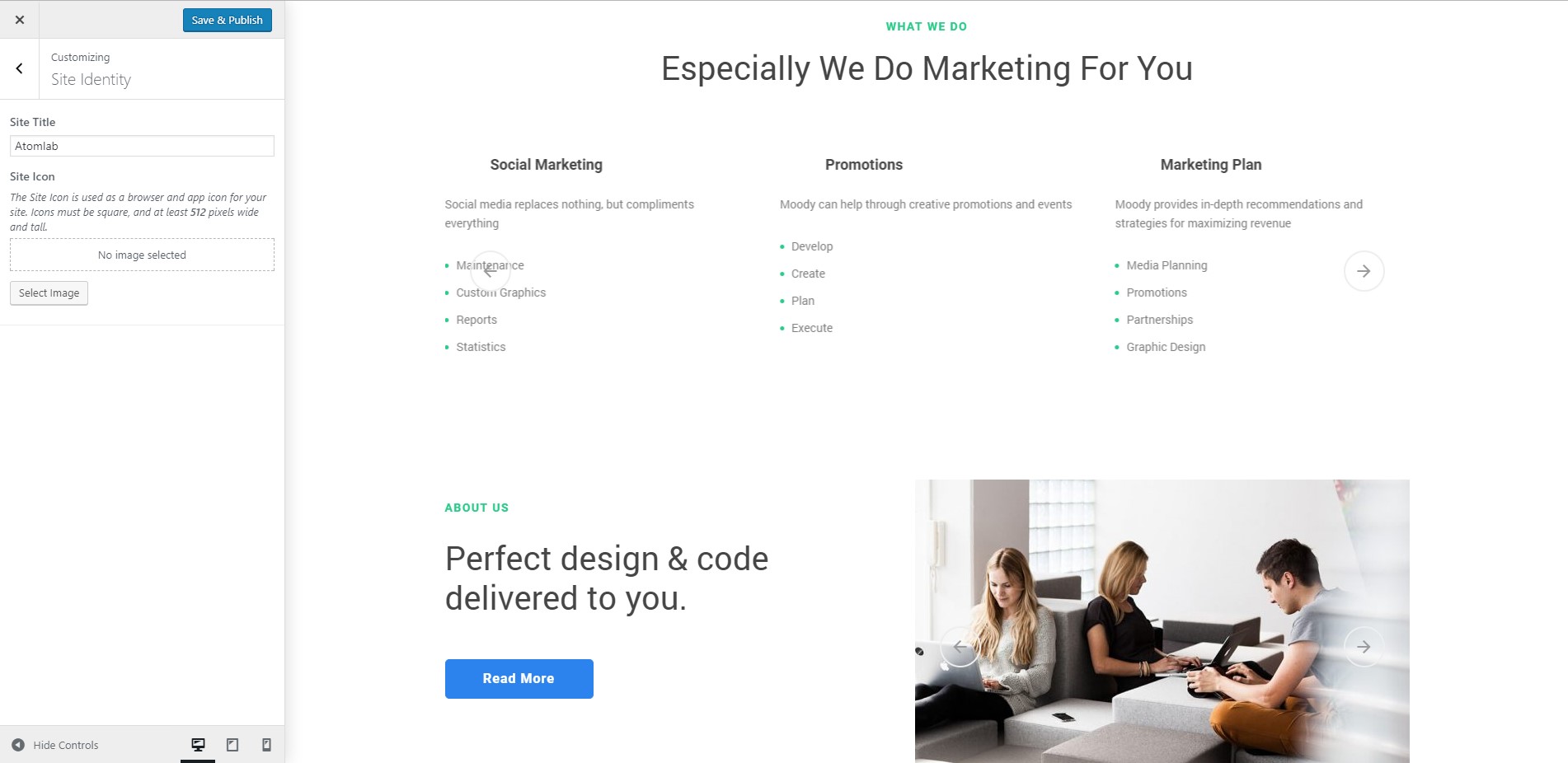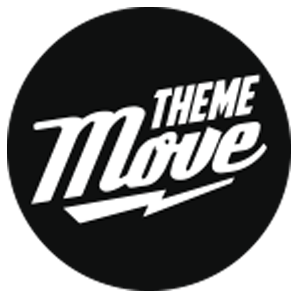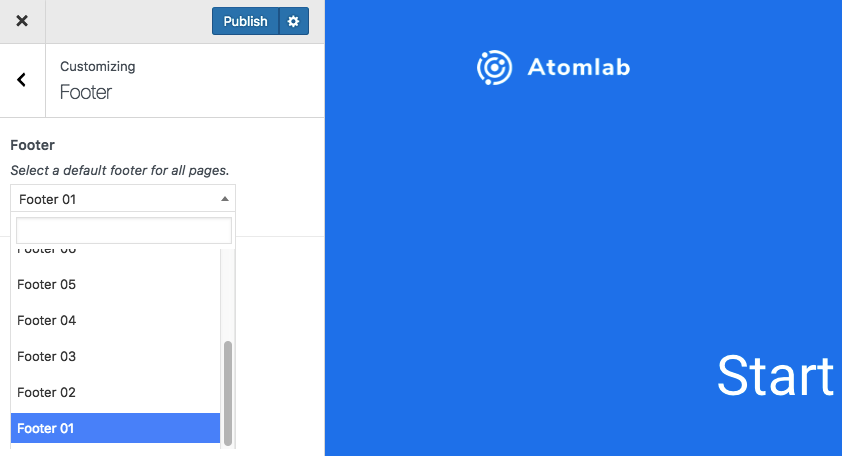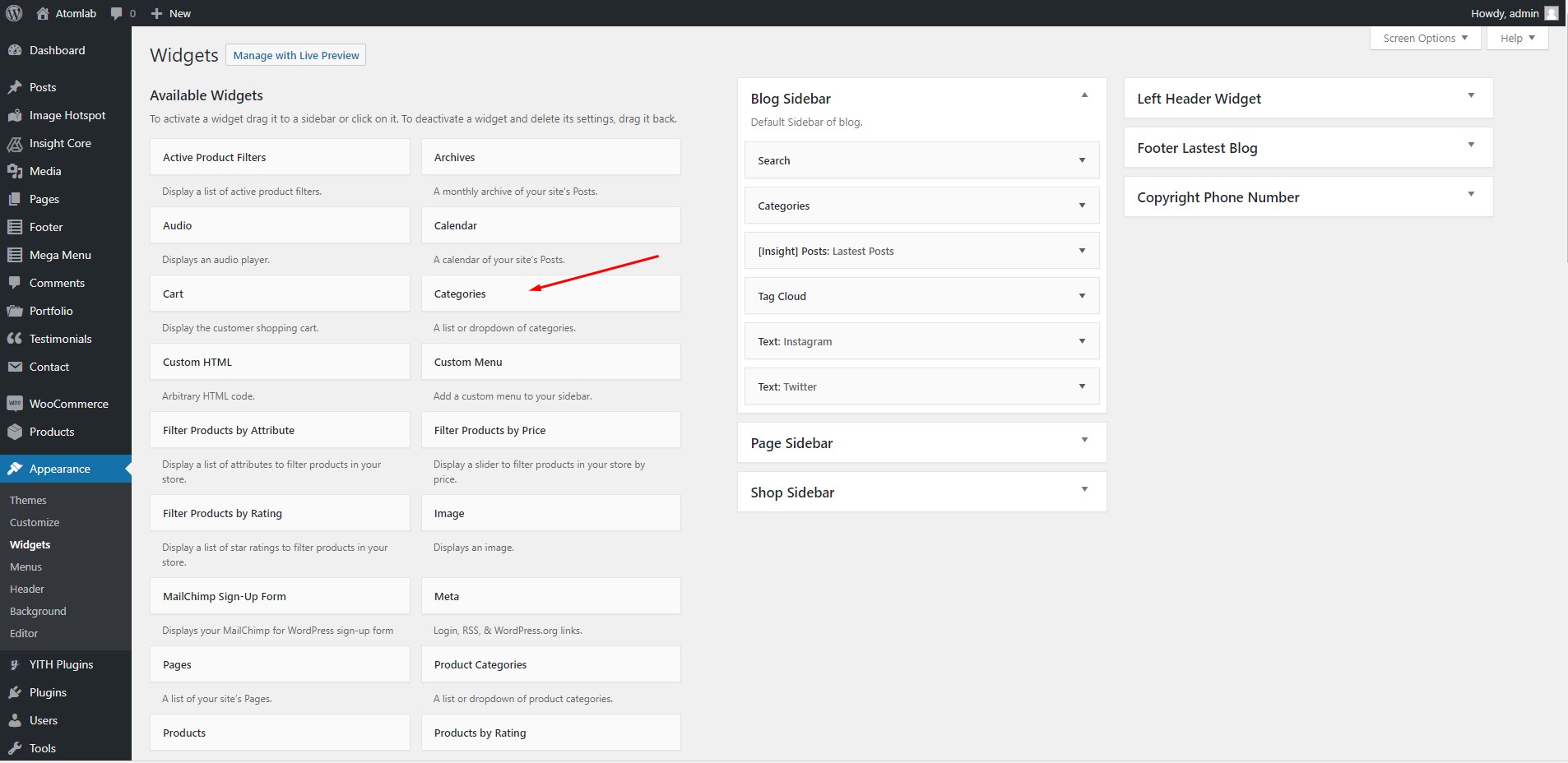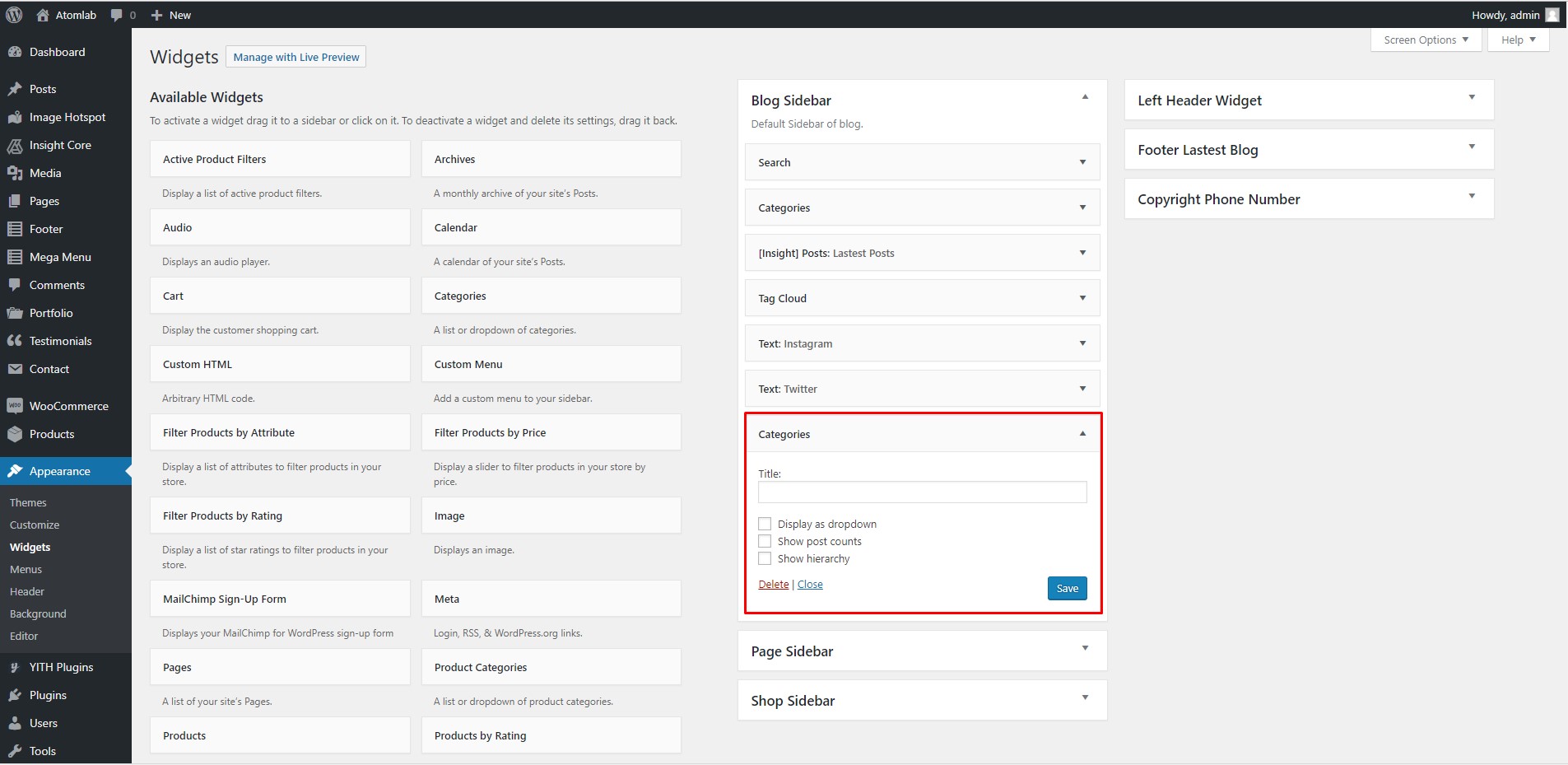Getting Started
Welcome to Atomlab
Hi,
It’s awesome to know that you decided to purchase Atomlab. No doubts, you will join
our happy customers community in seconds!
You won’t make any mistake here, because our detailed documentation will guide you.
Please be sure to check it out before getting started. We have outlined all kinds of
necessary information and keep them easy-to-read-and-follow. Our theme is based on
WordPress platform, so we assume that you have already WordPress installed and ready
to go.

If you are unable to find your answer in this documentation, don’t hesitate to sign
up & submit a support ticket here: ThemeMove’s Support
Channel with your site’s FTP and WordPress Admin details. Our top-notch support
team are extremely enthusiastic to solve your issue as soon as possible, just give
them a chance.
Enjoy your time here.
Cheers,
ThemeMove.
Theme Requirements
To use Atomlab, you must be running WordPress 4.4 or higher, PHP 5.6 or higher, and MySQL 5 or higher. We have tested it with Mac, Windows and Linux. Below is a list of items you should ensure your host can comply with.
Check to ensure that your web host has the minimum requirements to run WordPress.
Always make sure they are running the latest version of WordPress.
You can download the latest release of WordPress from official WordPress website.
Always create secure passwords for FTP and Database.
Hosting is more secure when PHP applications, like WordPress, are running using your account’s username instead of the server’s default shared username (www or www-data). The most common way for hosting companies to do this is using PHP. Just ask your potential host if they run PHP or something similar.
Recommended PHP Configuration Limits
Many issues that you may run into such as: white screen, demo content fails when importing, empty page content and other similar issues are all related to low PHP configuration limits. The solution is to increase the PHP limits. You can do this on your own, or contact your web host and ask them to increase those limits to a minimum as follows:
Max_execution_time 300
Memory_limit 128M
Post_max_size 32M
Upload_max_filesize 32M
Recommended PHP Configuration Limits
You can verify your PHP configuration limits in the System tab in the
Backend-mainpage. Take a look in the left sidebar for Atomlab back end > Insight
Core > system.

Your mission is make those 4 sections turn from yellow to green.
Tips For This Part :


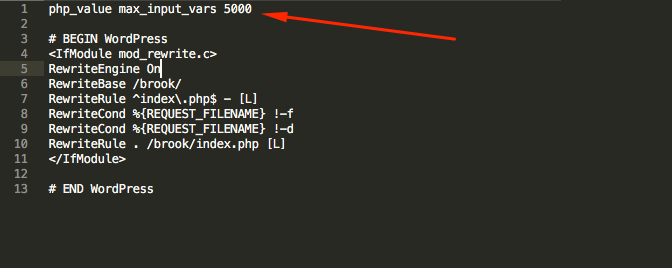
How to choose PHP version and enable PHP extension?
Step 1: Come CPanel find select PHP version
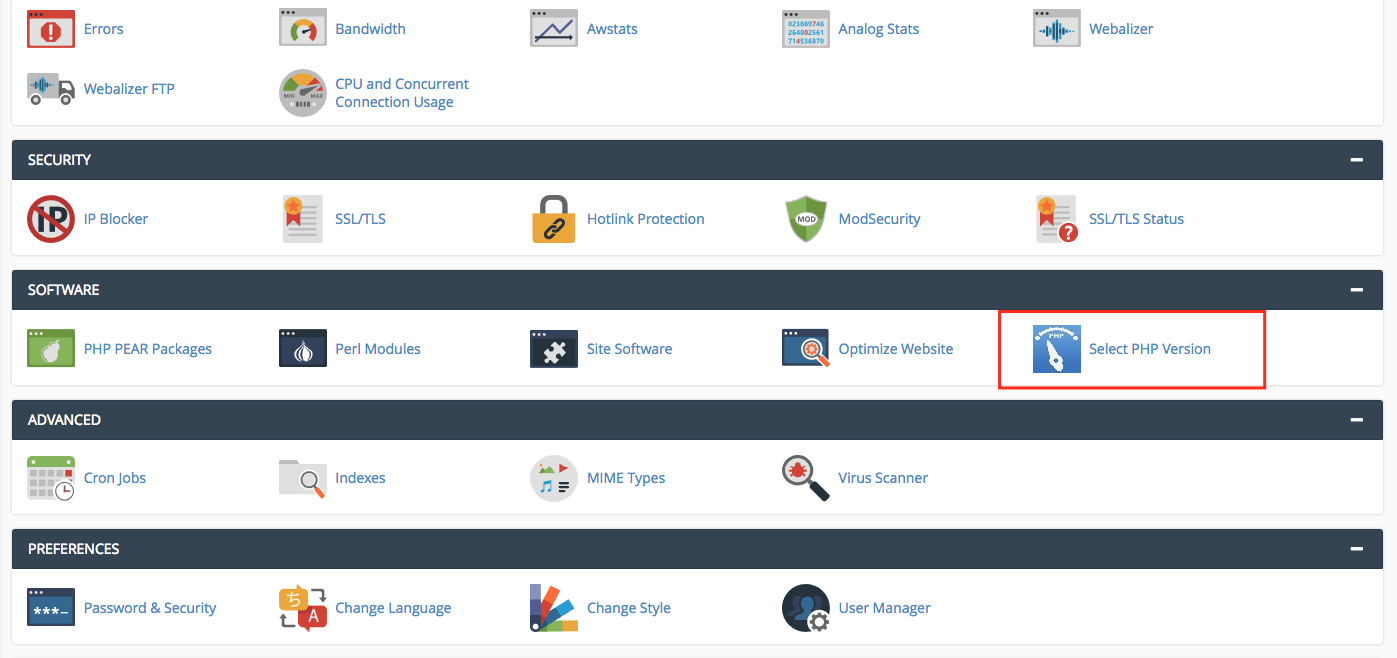
Step 2: Choose version 5.6 and enable XML reader extension
Step 3: Save the file
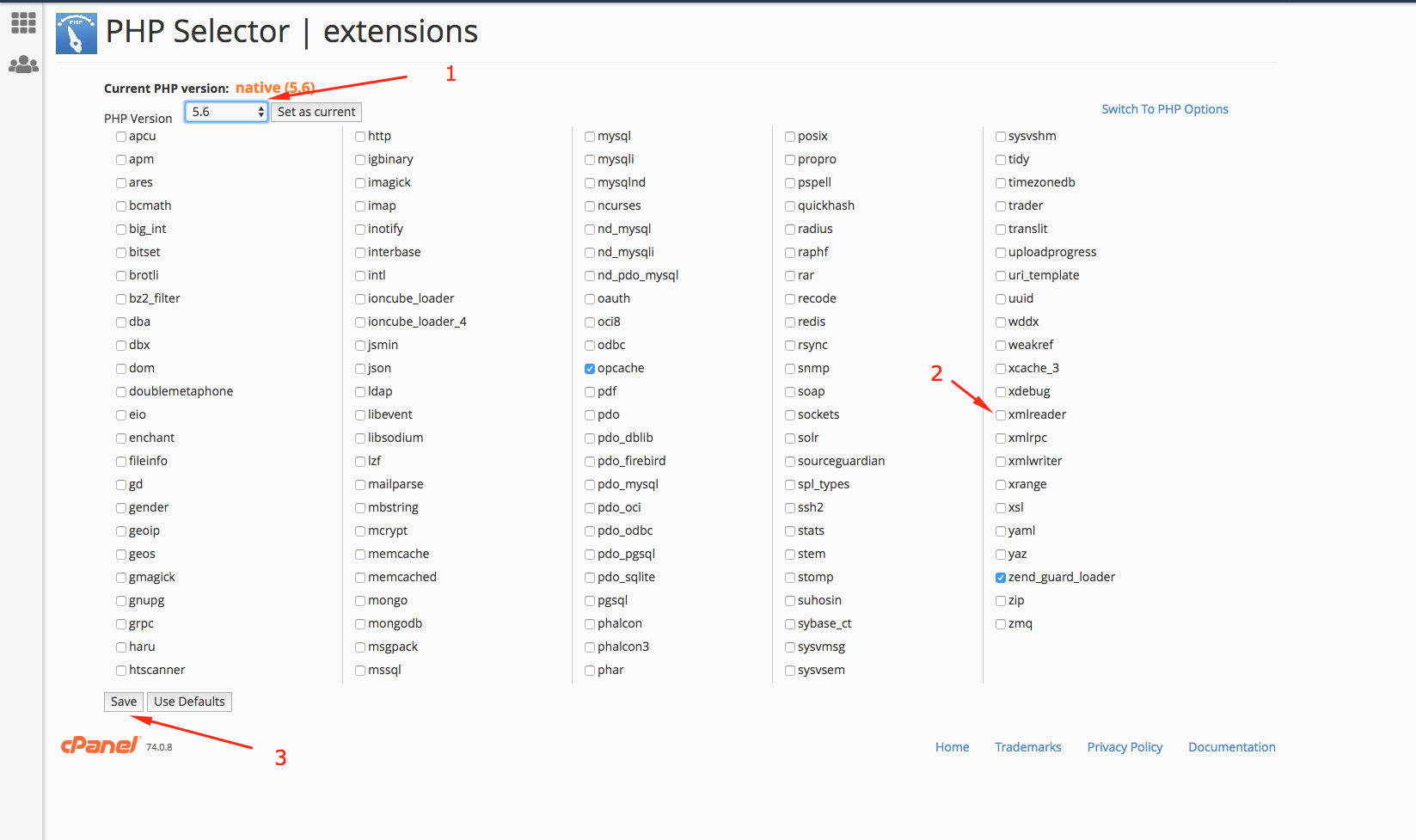
WordPress Knowledge Base
To install Atomlab – your powerful WordPress theme, you must have a working version of WordPress already installed. If you need help installing WordPress, follow the instructions in WordPress Codex. Below are all the useful links for WordPress information:
WordPress Codex – General info about WordPress and how to install on your server.
First Steps With WordPress – General info about multiple topics about WordPress.
FAQ New To WordPress – The most popular FAQ’s regarding WordPress.
What’s Included
When you purchase Atomlab from ThemeForest, you need to download the Atomlab files from your ThemeForest account. Navigate to your downloads tab on ThemeForest and find Atomlab.
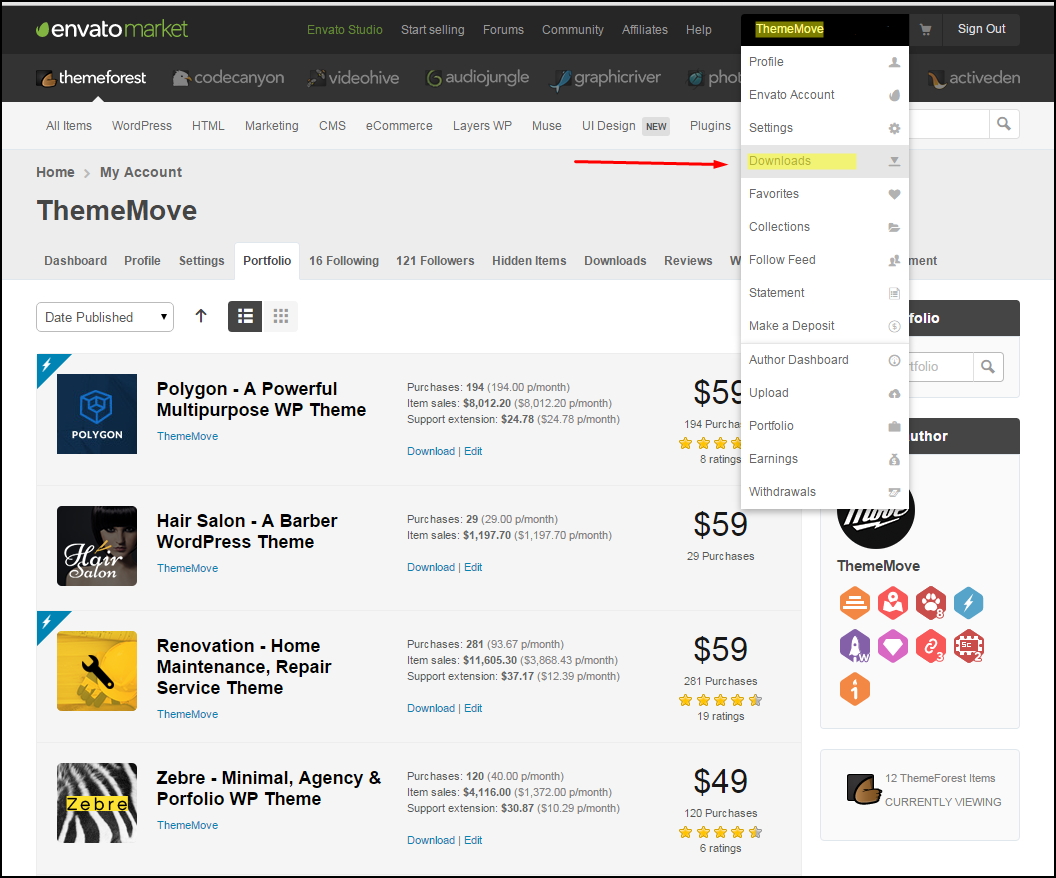
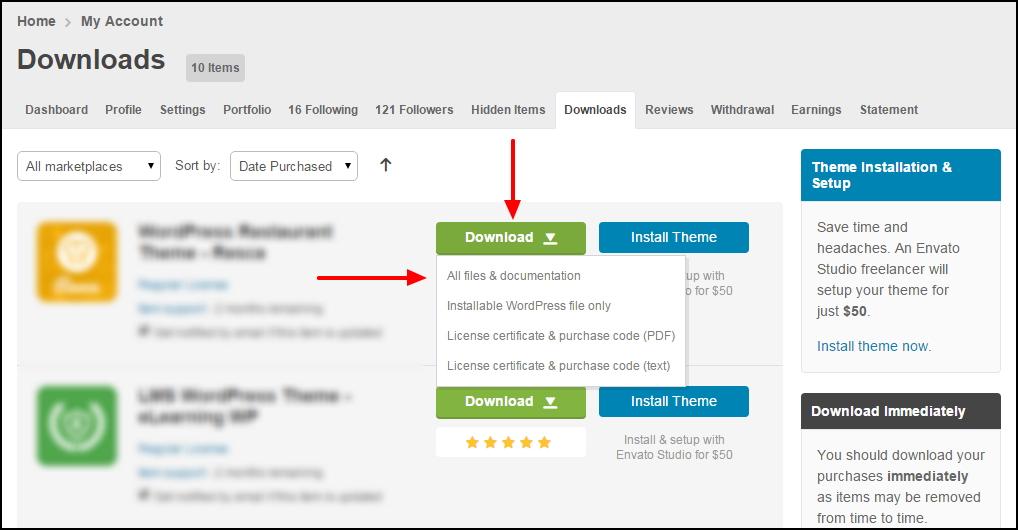
Click Downloads to see these two options.
-
Installable WordPress file only. You can upload this file when you install the theme.
All files and documentation (full zip folder). You will need to extract and locate the installable WordPress file to upload when you install the theme.
Atomlab’s Support System
All of ThemeMove’s items come with 6 months of included support and free lifetime updates for your Theme. Once the 6 months of included support is up, you have the opportunity to extend support coverage up to 6 or 12 months further. If you choose to not extend your support, you will still be able to submit bug reports via email or item comments and still have access to our online documentation knowledge base and video tutorials.
Envato clarifies item support policy here.
We have an advanced, secure ticket system to handle your requests. Support is limited to questions regarding the theme’s features or issues that are related the theme. We are not able to provide support for code customizations or third-party plugins. If you need help with anything other than minor customization of your theme, we suggest enlisting the help of a developer.
How To Start Receiving Support
Step 1 – Click Here to create an account. You will need your accession which can only be received after buying the theme from Themeforest.net.
Step 2 – Once you are signed up, you need to sign into our support center with your new account.
Step 3 – Follow these steps before you submit a support ticket.
Step 4 – To create a new ticket, hit New.
See how to take your purchase code:
Hit Download then choose License Certificate & Purchase Code.

Before You Submit Ticket
To help speed along your request, we require that you follow the steps below before posting a ticket in the Help Desk.
Step 1 - Please take a moment to search the Basic Troubleshooting Issues, as the answer to your question is likely already in here - nearly 80 % of all tickets opened are due to the issues described in this guide.
Step 2 – If your question or issue has not been brought up, then please open a ticket with the following information:
Your live site URL that shows the issue
Your WordPress login credentials
Did you install or update the theme? Using FTP or from the WordPress admin panel?
Specific browser or device involved if applicable - Operating System version( Windows 8.1, Maverick etc), the model of the device( Ipad 3, Samsung Galaxy etc.), browser version( Safari 7, IE 11) etc. and screen resolution 1600/800 1440/900 etc.
Detailed information describing the issue
Possible screenshots of the issue
Please note that in most case the support staff cannot do much without this information. So to avoid unnecessary delays please provide the information above.
Also please deactivate all the plugins that don't come with the theme, this will allow us to rule out any third party plugins conflict. We don't deactivate the plugins on a client's site, because sometimes this may cause unforeseen issues.
Installation
Theme Installation
After purchasing Atomlab, please download the package from ThemeForest. All you need to do is moving your mouse over your login name at the right top corner – after you log in ThemeForest, and then click Downloads.

Here you will find all the items that you have purchased. Hover to Download button next to Atomlab, you will see these download options:
Installable WordPress file only which you can upload when installing theme
All files & documentation (full zip folder). You will need to extract and locate the installable WordPress file to upload when installing theme
You should choose to download all files & documentation as a child theme is included there for you to use later.

Install theme via WordPress
Step 1 - Navigate to Appearance > Themes

Step 2 - Click Add New, then click Upload Theme > Choose File

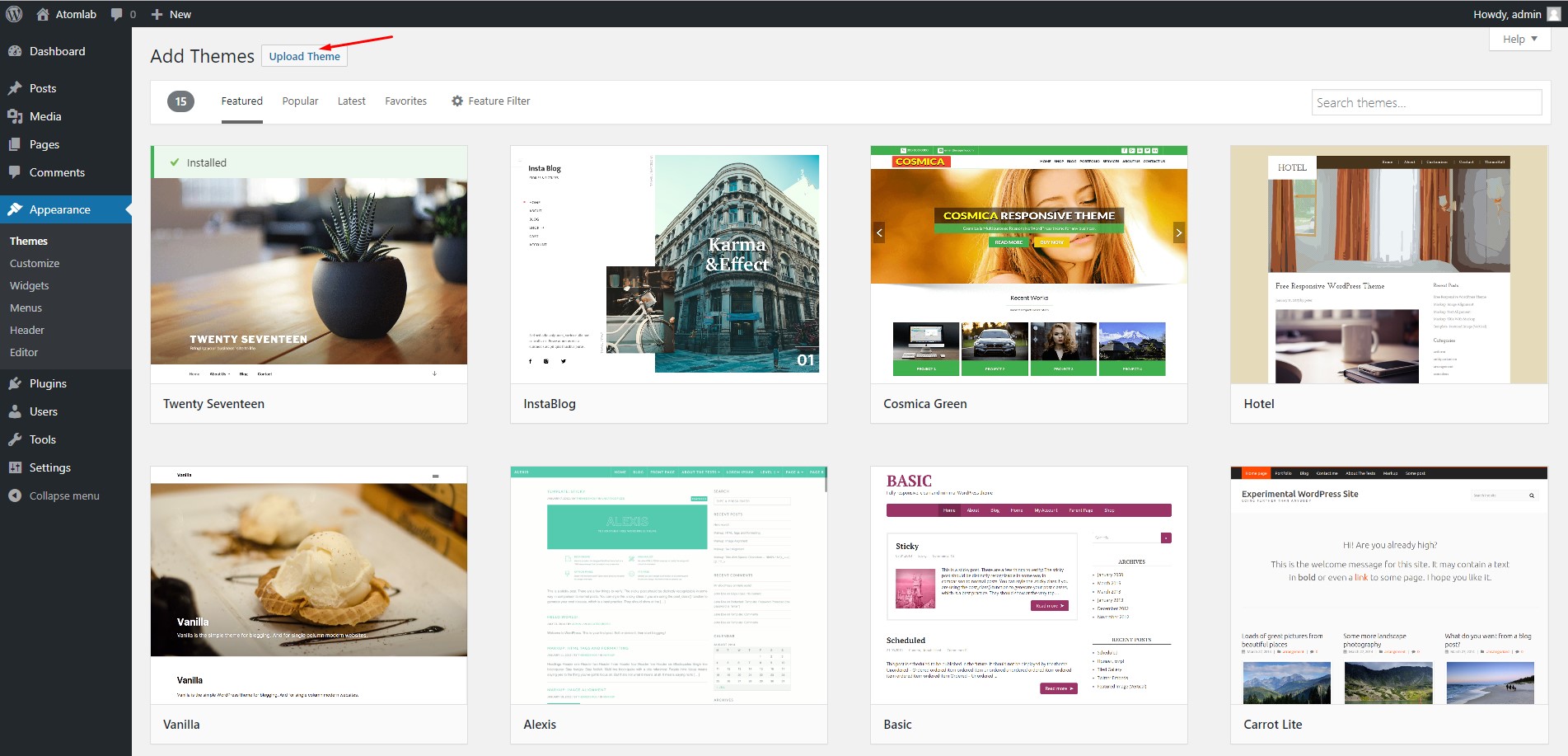

Step 3 - Navigate to the .zip file on your computer, then click Install Now

After activating, you should be redirected to the themes page with TM Atomlab activated:
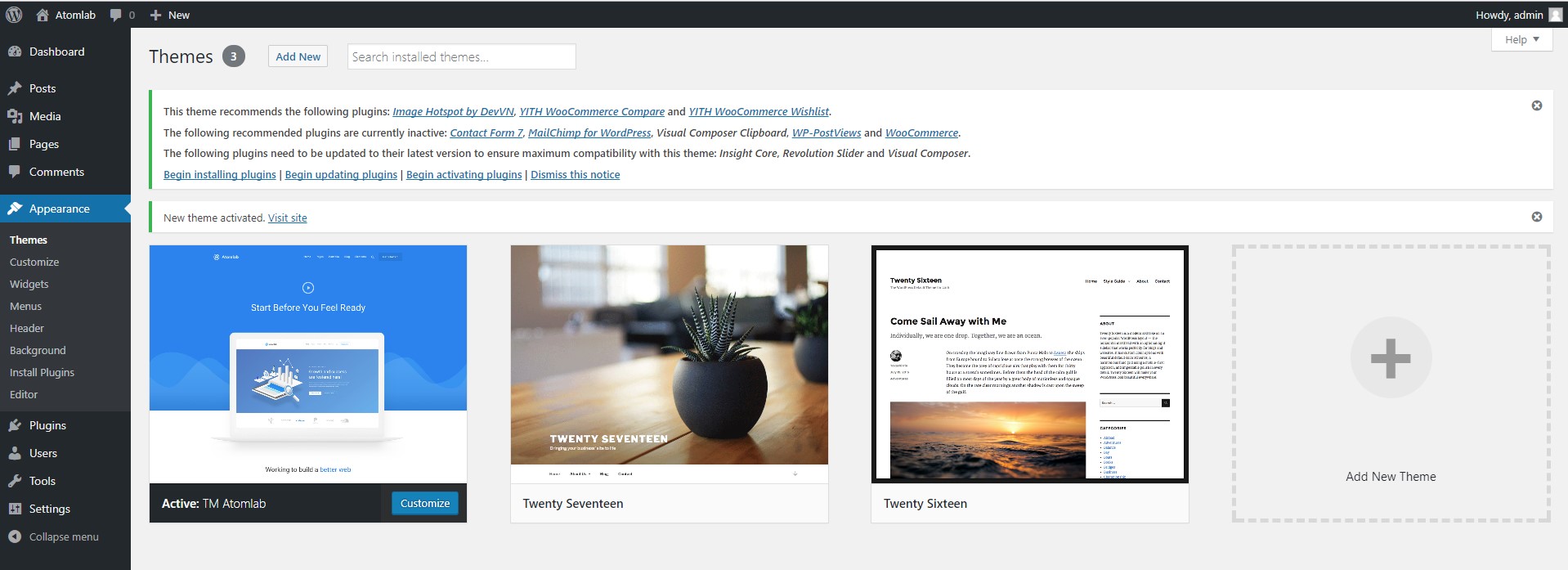
Install theme via FTP
Step 1: Unzip zip file package – the zip package is inside Atomlab files folder you have downloaded from ThemeForest
 Step 2: Connect to your FTP server and navigate to the folder where your WordPress is installed.
Step 3: Go to wp-content/themes/ and upload theme folder (the path will look like this: wp-content/themes/tm-atomlab)
Step 2: Connect to your FTP server and navigate to the folder where your WordPress is installed.
Step 3: Go to wp-content/themes/ and upload theme folder (the path will look like this: wp-content/themes/tm-atomlab)
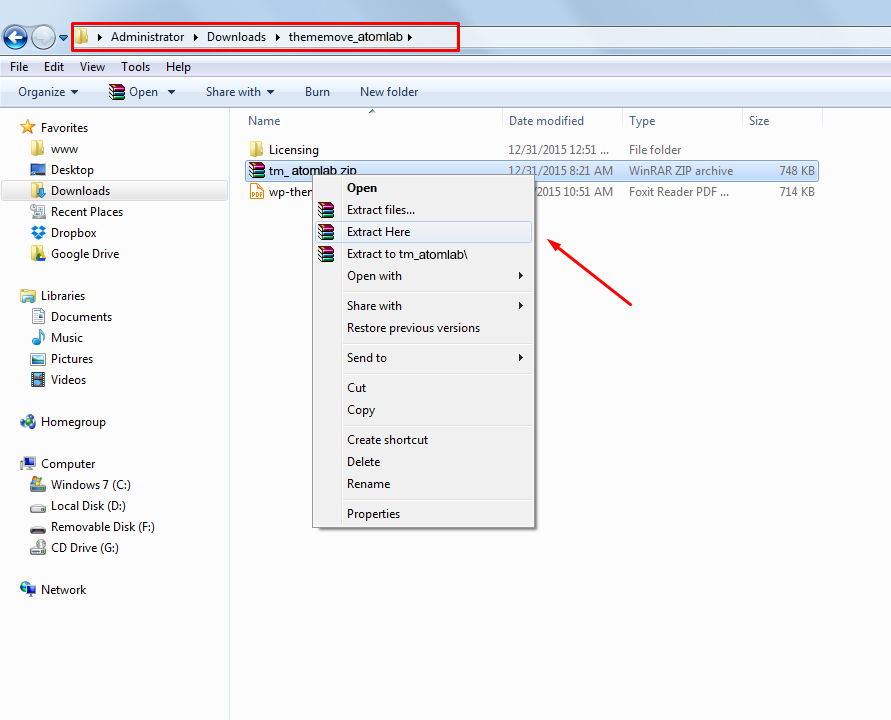 Step 4: Open WordPress admin panel (navigate through the web-browser to the folder where you have installed the WordPress e.g www.yourdomain.com/wp-admin/) and go Appearance > Themes on admin sidebar. Activate Atomlab
IMPORTANT! After theme installation, at the top, you have a box with
information about required and optional plugins. To install them and activate,
please navigate to Appearance > Install Plugins section, and install only necessary
plugins.
Step 4: Open WordPress admin panel (navigate through the web-browser to the folder where you have installed the WordPress e.g www.yourdomain.com/wp-admin/) and go Appearance > Themes on admin sidebar. Activate Atomlab
IMPORTANT! After theme installation, at the top, you have a box with
information about required and optional plugins. To install them and activate,
please navigate to Appearance > Install Plugins section, and install only necessary
plugins.
Plugin Installation
After activating Atomlab, you will see this notice:
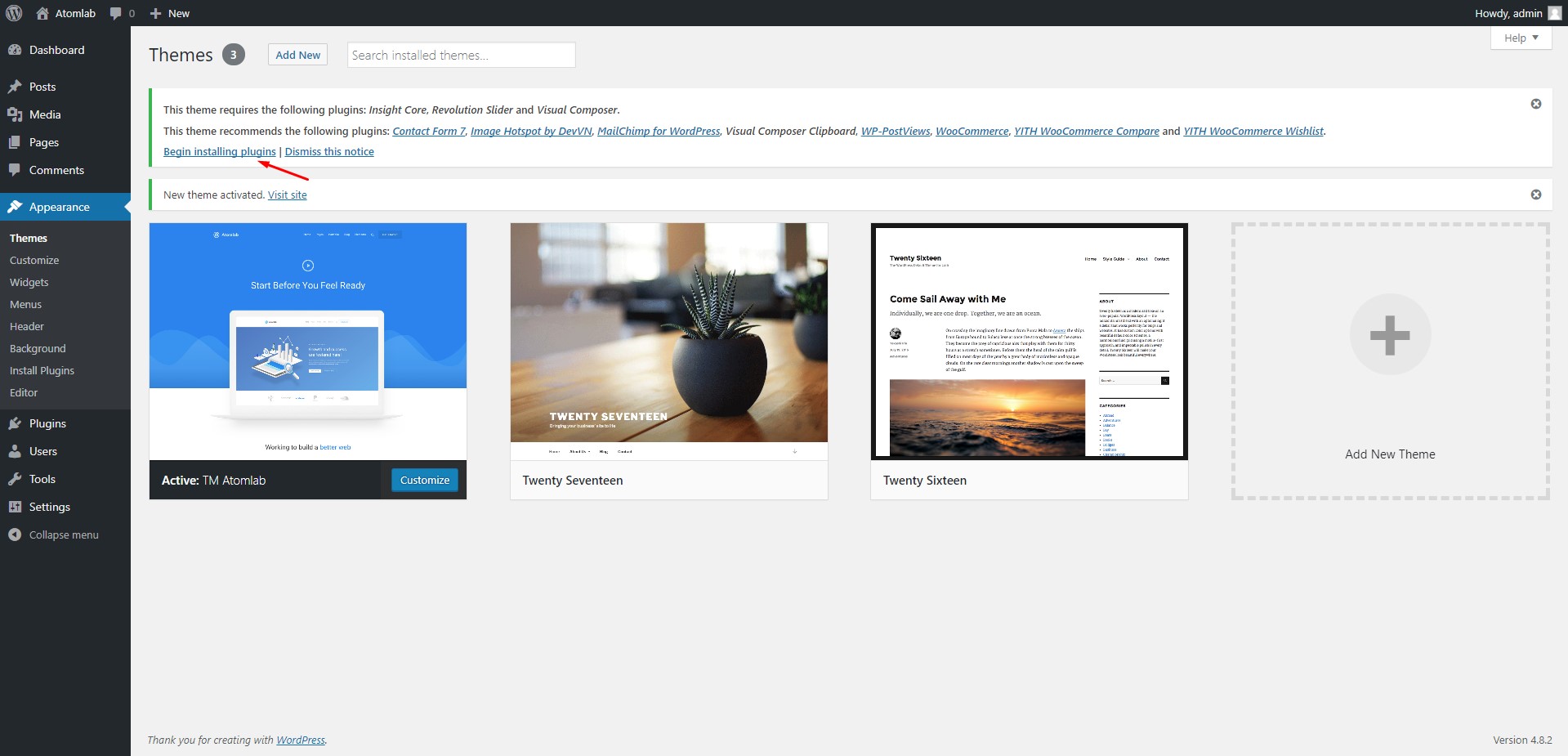
Click Begin installing plugins. You will be navigated to Install Required Plugins page.
Simply check all of them (or all of required plugins and some recommended plugins you like) and from the drop down select Install, then hit Apply.
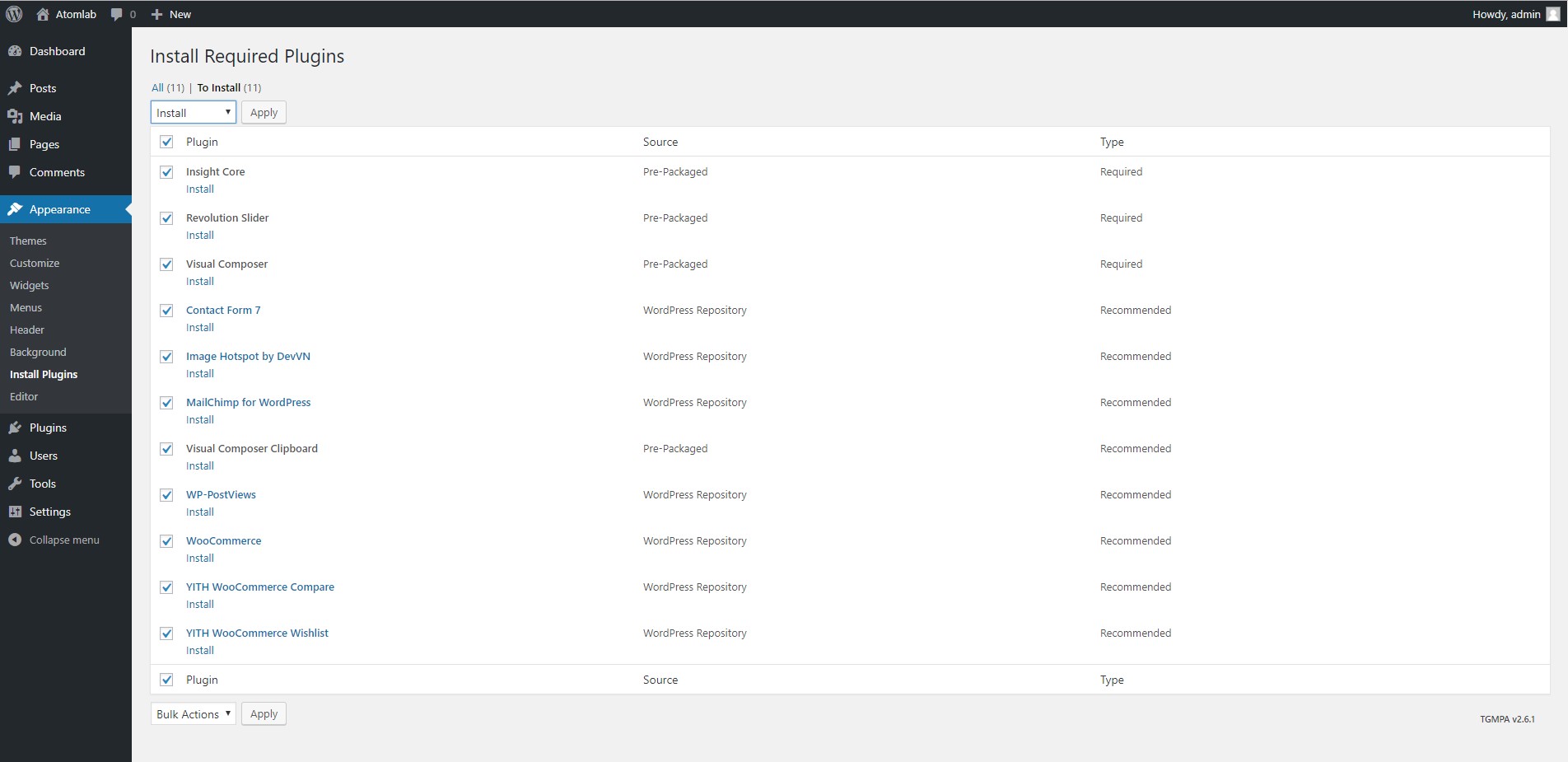
When finishing, it should look like this:
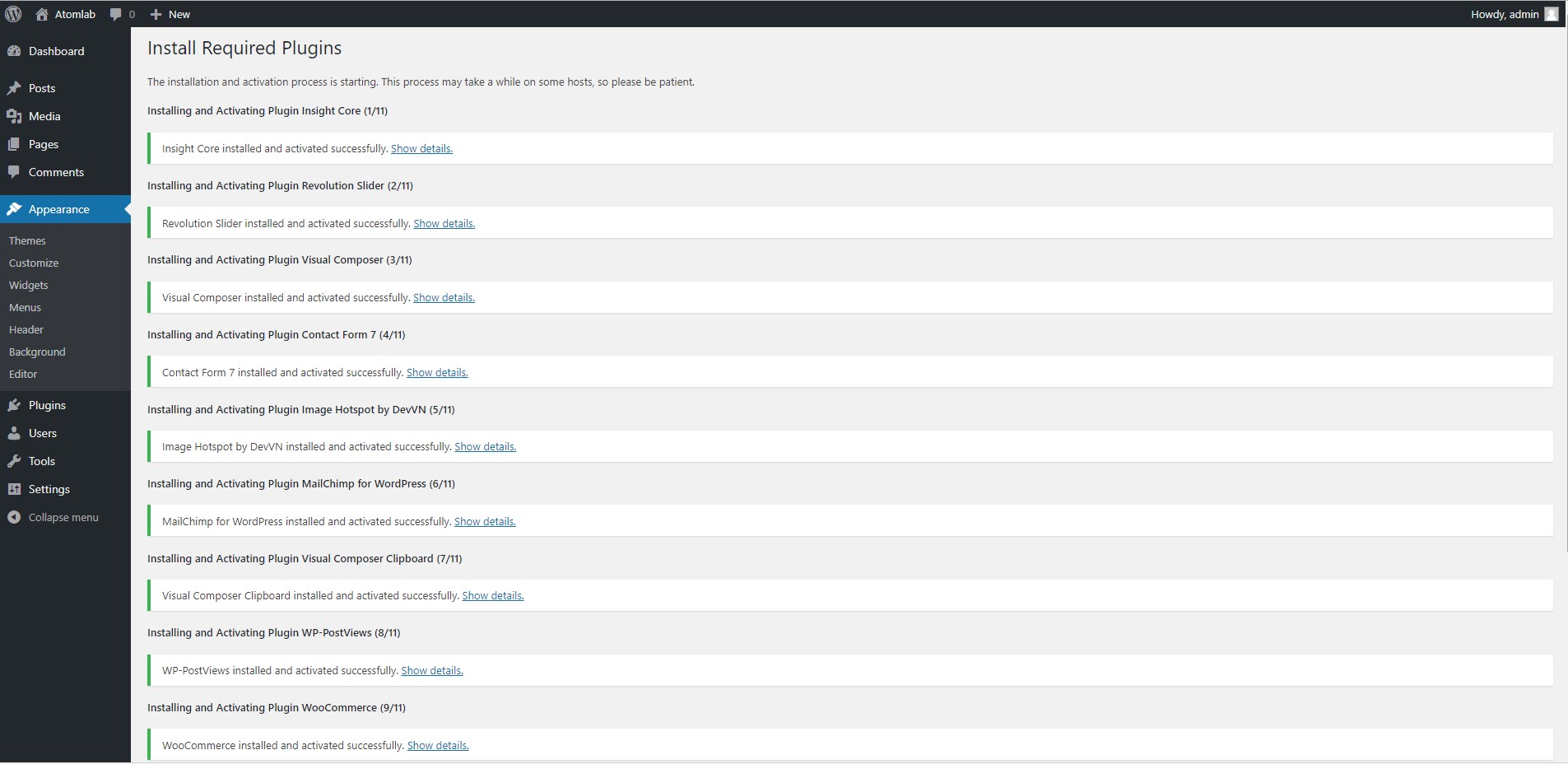
Required plugins: Insight Core, Visual Composer, Revolution Slider
Recommended plugins: Visual Composer Clipboard, Essential Grid, WooCommerce,
Contact Form 7, MailChimp for WordPress, WP-PostViews
Plugin Configuration

Insight Core
Insight Core is a required plugin for all Thememove themes. It manages many important tasks including plugin installation, demo data import, update notification. Users will also find information of documentation and support link there.

WooCommerce
An amazing eCommerce plugin that allows you to sell anything, beautifully. Built to integrate seamlessly with WordPress, WooCommerce is the world’s favorite eCommerce solution that gives both store owners and developers complete control.

Visual Composer
Visual Composer for WordPress is drag and drop front-end and back-end page builder plugin that will save you tons of time working on the site content. You will be able to take full control over your WordPress site, build any layout you can imagine – no programming knowledge required. Moreover, now you can choose either work on a backend or move your page building process to frontend and instantly see changes you make.
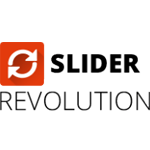
Slider Revolution
Slider Revolution is an innovative, responsive WordPress Slider Plugin that displays your content in a beautiful way. Whether it’s a Slider, Carousel, Hero Scene or even a whole Front Page, the visual, drag & drop editor will let you tell your own stories easily.
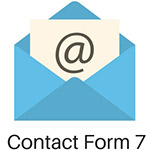
Contact Form 7
Contact Form 7 can manage multiple contact forms, plus you can customize the form and the mail contents flexibly with simple markup. The form supports Ajax-powered submitting, Captcha, Akismet spam filtering and so on.

Mailchimp For WordPress
MailChimp for WordPress helps you add more subscribers to your MailChimp lists using various methods. You can create good looking opt-in forms or integrate with any other form on your site, like your comment, contact or checkout form.

Footer Designer
Easy way to create any footers you can imagine for your sites.
Demo Installation
Our demo data import lets you have the whole data package in minutes, delivering all kinds of essential things quickly and simply. All you need to do is to navigate to Insight Core > Import. Hit Import this demo.
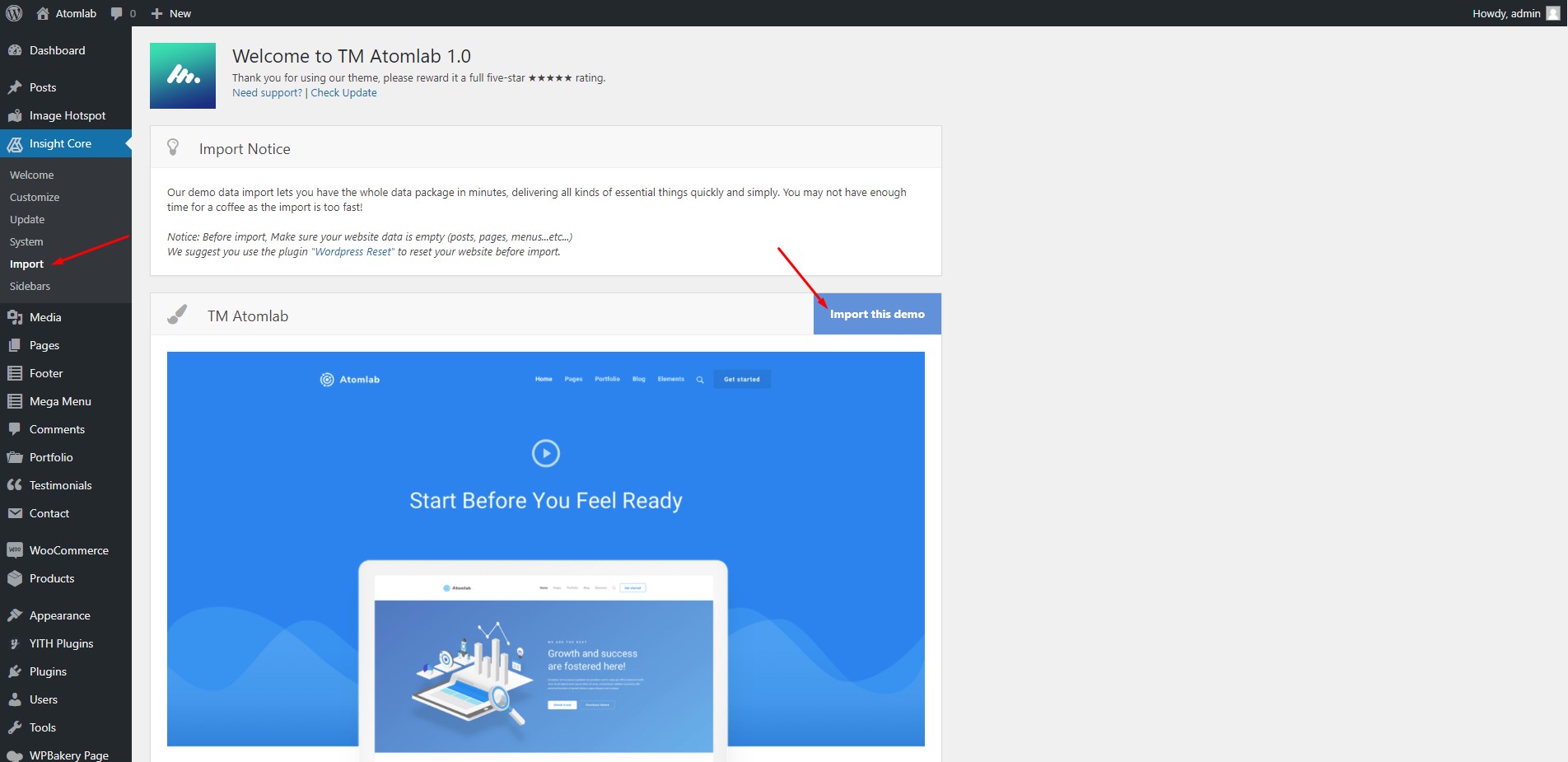
Have a cup of coffee. The process is within minutes.

When finishing, it should look like this:

Go to Setting > Reading > Front page displays and choose the page you like to be your front page then hit Save changes.

Common Installation Issues
If you run into trouble when installing Atomlab, please check out Common Installation Issues for solutions. If it's not there, please contact us for support.
Update
Before Updating
1. It Is Always Recommended To Backup Your Current Setup
We recommend you have a current backup of your site. Simply go to Theme Options
>> Import / Export and export your backup.
2. Do Not Keep Older Copies of The Theme In WP Theme Folder
You should completely remove all previous theme folders before adding the new
updated theme folder. Don't just rename the theme folder. If you rename your theme
folder when you update, then the path will be no longer valid. Because WordPress
stores menus and widget settings and some other settings by folder path, you will
need to rename your theme folder back to what it was before, then your settings,
menus, widgets will be restored. So the total renaming process has no meaning.
3. Reset Browser Cache, Server Cache And Plugin Cache
It is always recommended to reset your browser, plugin, and server cache when you
update. Visual issues may happen and more often than not, its caused by caches, and
they need to be emptied. Each browser allows you to remove cookies, history and
other data. If your theme or ThemeMove Core version is not updated after uploading
the new files, it is due to a server-side caching system. Some hosting providers
have server-side cache systems installed to optimize the speed of content delivery,
please clear any server-side cache or ask your host to do it. This is also true for
google pagespeed setups or cloudflare setups.
4. Update Child Theme
If you have copied template files from parent theme to child theme, please make sure
to revert to parent theme first to confirm if the issue exists there too. If it
doesn’t, please update the templates copied to child theme with the parent
theme.
5. Required & Recommended Plugins Must Be Updated
When you update the theme, you will see a notification message in your admin telling
you the required and recommended plugins need to be updated. Follow the onscreen
prompts to install the plugin updates. We have listed some required plugins and they
have to be installed and activated for theme features to work. Make sure you are
always using the most recent version of these plugins. You will be prompted to
install it upon installing or updating your theme. If you dismiss the prompt or do
not see it, then you can go to Plugins >> Installed Plugins >> Update
Available (if have) and update the plugins there.
Update Theme
Firstly, you need to download the new theme package from your Themeforest account.
Once you have the new theme package, you can choose to upload the theme via
WordPress or via FTP.
1. Update theme via FTP
Step 1 – If you have downloaded Installable WordPress file only, please unzip
the tm-Atomlab.zip file. If you have downloaded the All file & documentation
package,
please unzip the tm-Atomlab.zip file and then unzip the secondary tm-Atomlab.zip
file
which
will give a tm-Atomlab folder.
Step 2 – Connect to your FTP.
Step 3 – Upload the extracted tm-Atomlab folder to: wp-content/themes/. Just
replace existing files and folders.
Step 4 – Lastly, update the included plugins. You will see a notification
message letting you know the plugins have a new version and need to be updated.
2. Update theme via WordPress
Step 1 – You need to deactivate the current Atomlab theme in Appearance >
Themes section by simply activating a different theme. Once you activate a
different theme, you can delete the Atomlab.


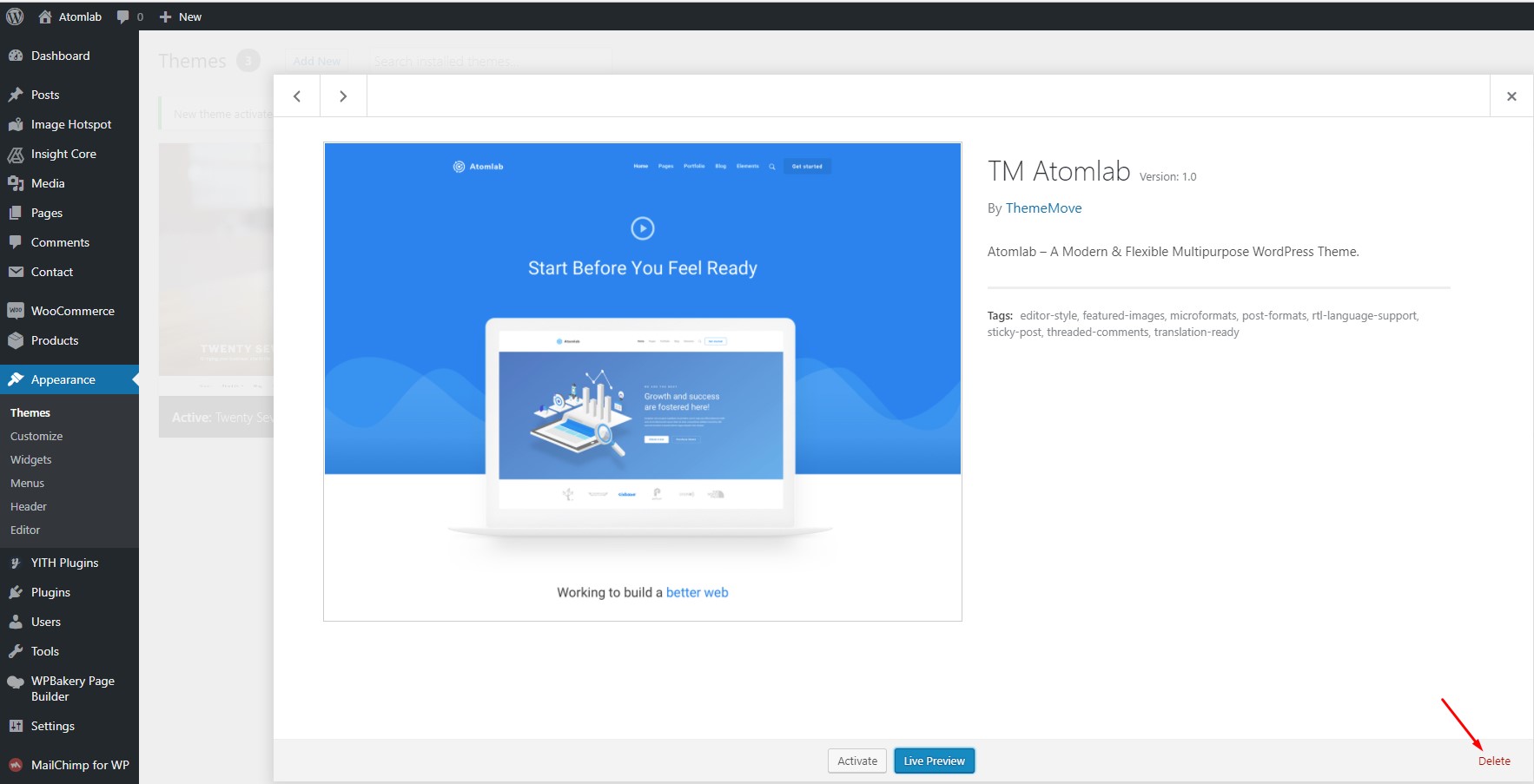
Step 2 – Retrieve the tm-Atomlab.zip file from your new Themeforest download.
If you download All files & documentation, then you need to unzip the archive file
you received, the tm-Atomlab.zip file will be inside of it.
Step 3 – Then simply upload and activate the tm-Atomlab.zip file in the Appearance
> Themes section like you've done when installing theme.
3. Update theme using Envato Toolkit
Step 1 – You need to generate an API key to link your WordPress site to your
ThemeForest account. Login to ThemeForest, go to your dashboard and click on
“Settings.” The API Keys screen allows you to generate a free API key.
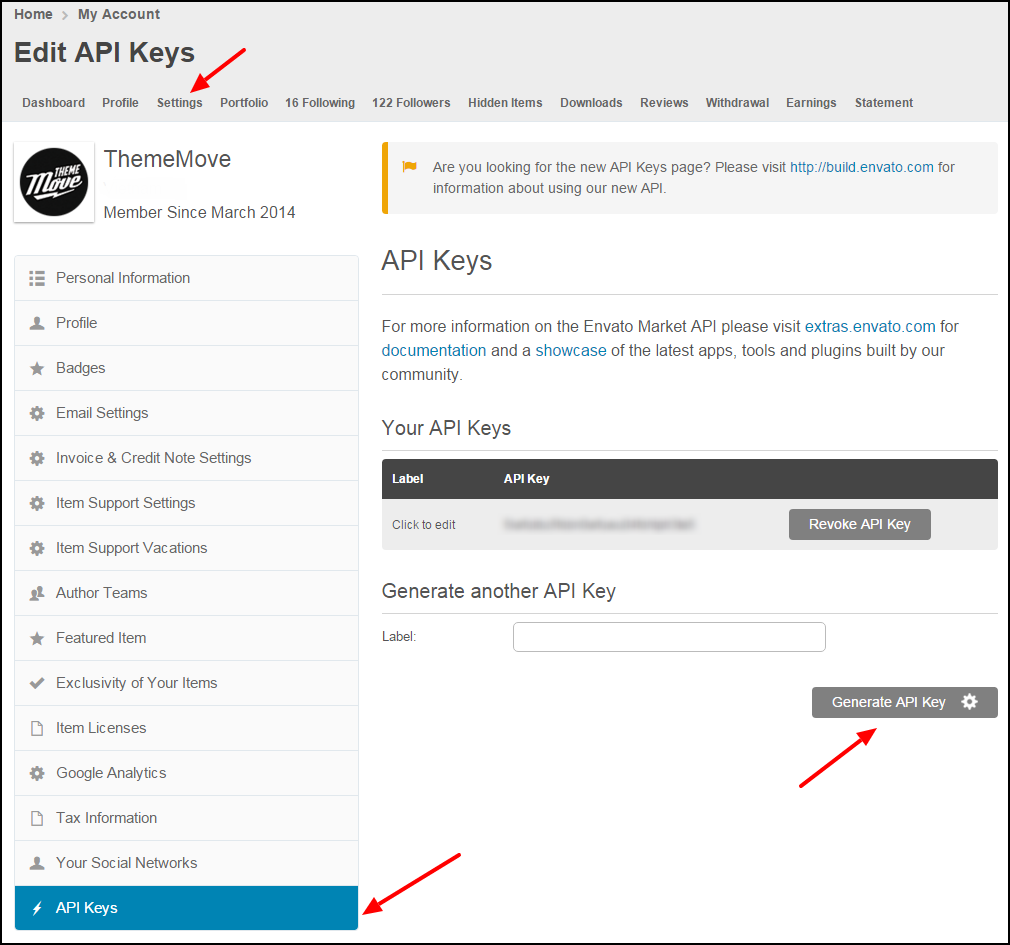
Step 2 – Download Envato
ToolKit, install and activate this plugin. A new menu item, “Envato Toolkit”,
will appear in the admin sidebar. Click on the sidebar link and enter your
marketplace username and secret API key. Click “Save Settings.” All of your theme
purchases will now appear on this page after it refreshes.
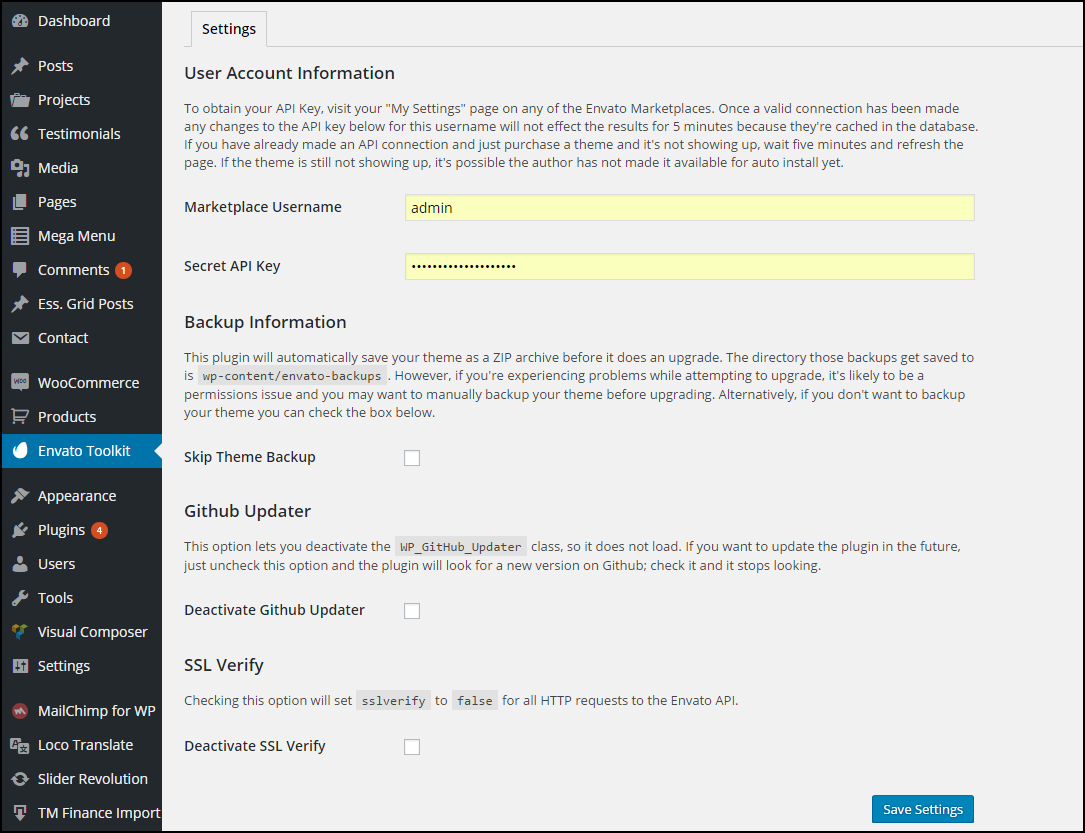
Step 3 – The plugin will now alert you to theme updates – so long as you
check the toolkit settings regularly. Click on install automatically beside
each of your themes to automatically update them. The toolkit settings page also
allows you to install themes that you haven’t already uploaded to your site, delete
ones you don’t use and view version details. You can also set up theme backups.

Build Your Site
WordPress Configuration
You can adjust WordPress settings as follows:
1. You can set Site Title, Tagline in Settings > General.

2. You can set Blog pages show at most, Front Page displays in Settings >
Reading.
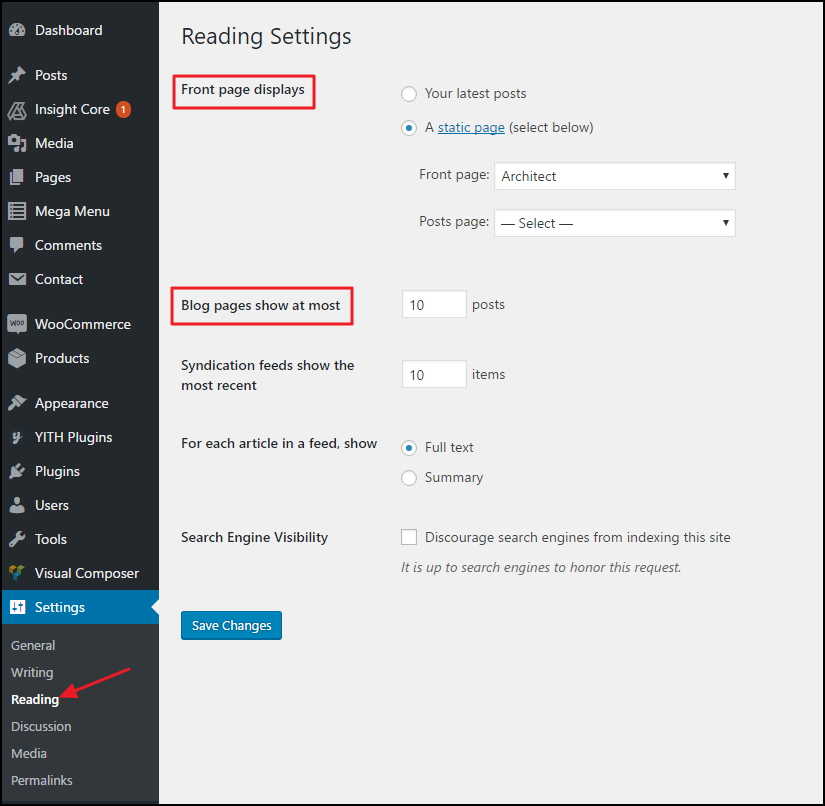
3. You can set Discussion settings in Settings > Discussion.

4. You can set Image sizes in Settings > Media.
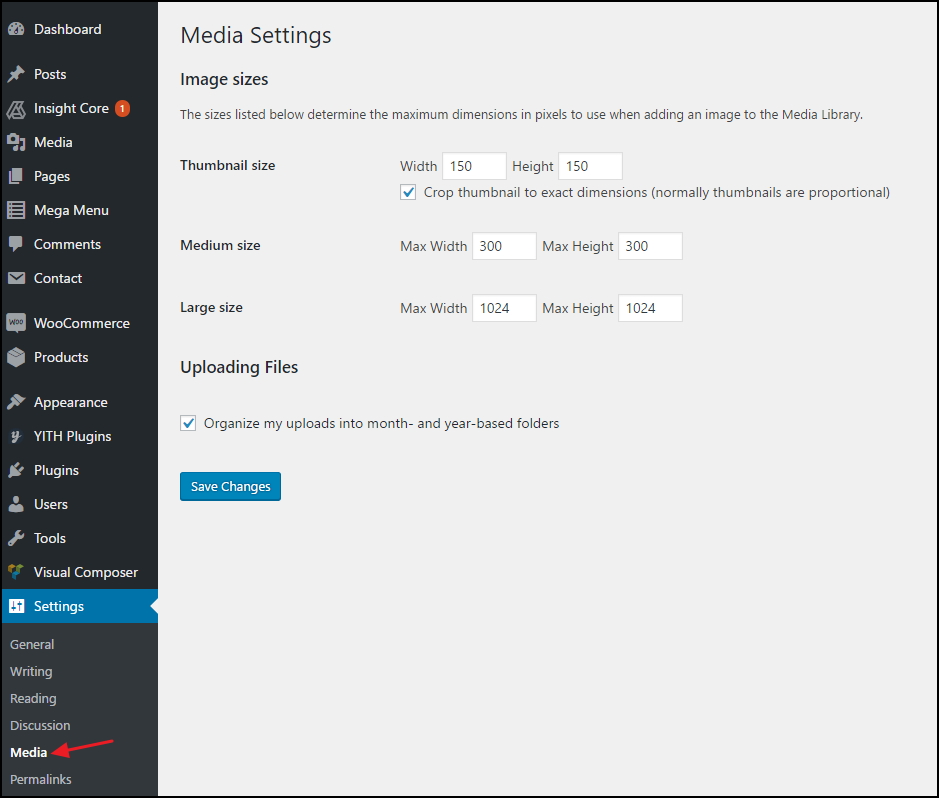
We used the following sizes on our demo sites:
Thumbnail size: 150 x 150
Medium size: 300 x 300
Large size: 1024 x 1024
5. You should ensure that a non-default permalink setting is selected, e.g. Day
and name in Settings > Permalinks.

Theme Options
Atomlab comes with advanced settings panel that is loaded with options.
We have the options organized into logical tabbed sections, and each option has a
description of what it will do on the front end. Because of the sizable amount of
options Atomlab provides, we cannot go over them in full detail here in our
documentation. We encourage you to please take some time and navigate through each
tab to see what we offer.
Go to Appearance > Customize on admin sidebar to access the setting options.
See below for screenshot of our Customize panel.

Page
Create A New Page
Step 1 – Navigate to Pages in your admin sidebar and click Add
New option.

Step 2 – Enter a new name for your page, then find the Page Attributes
box on right side to set your Parent or Template page.

Use Visual Composer To Build Page
Step 1 – Choose Backend Editor or Frontend Editor to edit your
page. Backend Editor gives you the backend interface while Frontend Editor gives you
the user interface. Visual Composer works with both.

Step 2 – Choose Add Element to start adding our premade elements to
your new page.
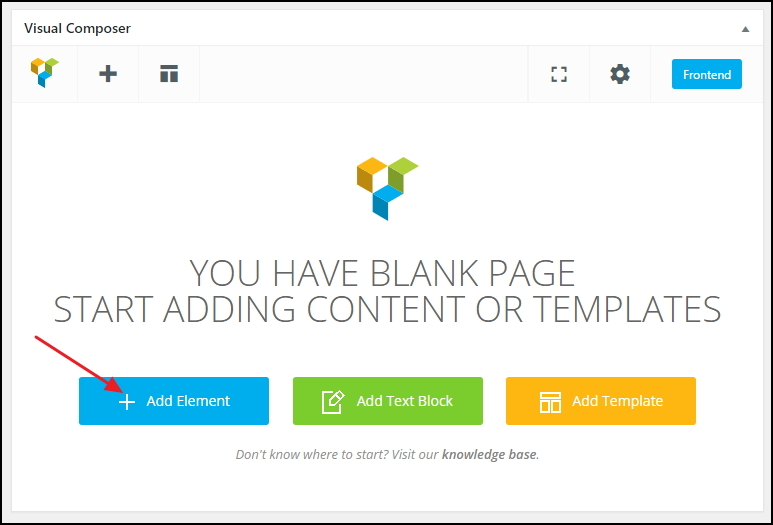
Step 3 – Choose elements you want to add to your new page in the element box
and start editing them.
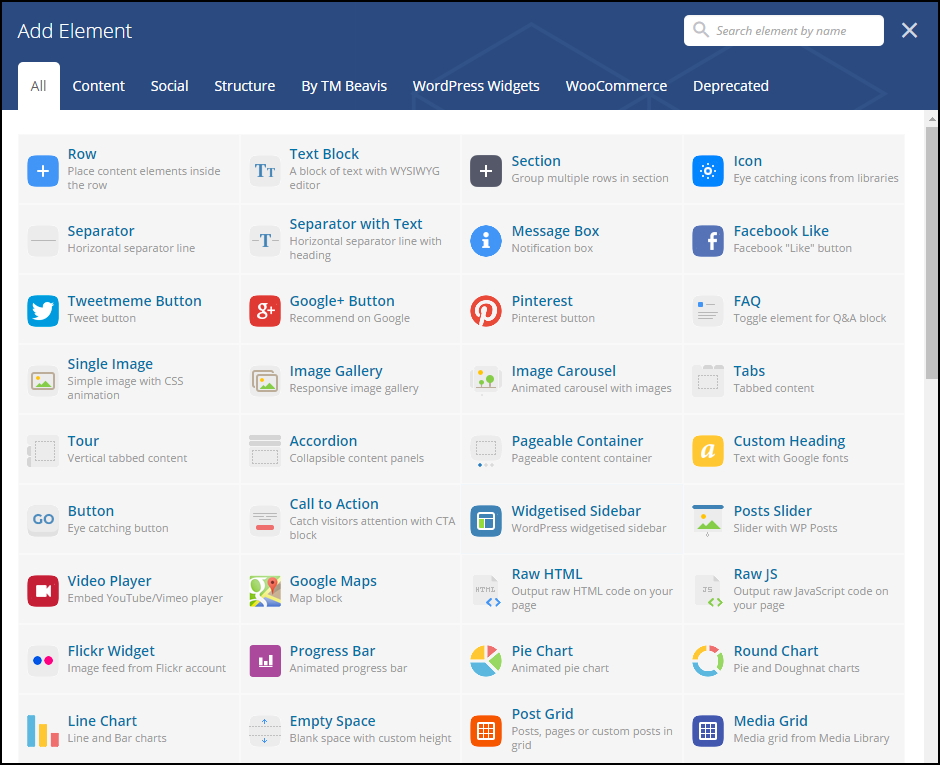
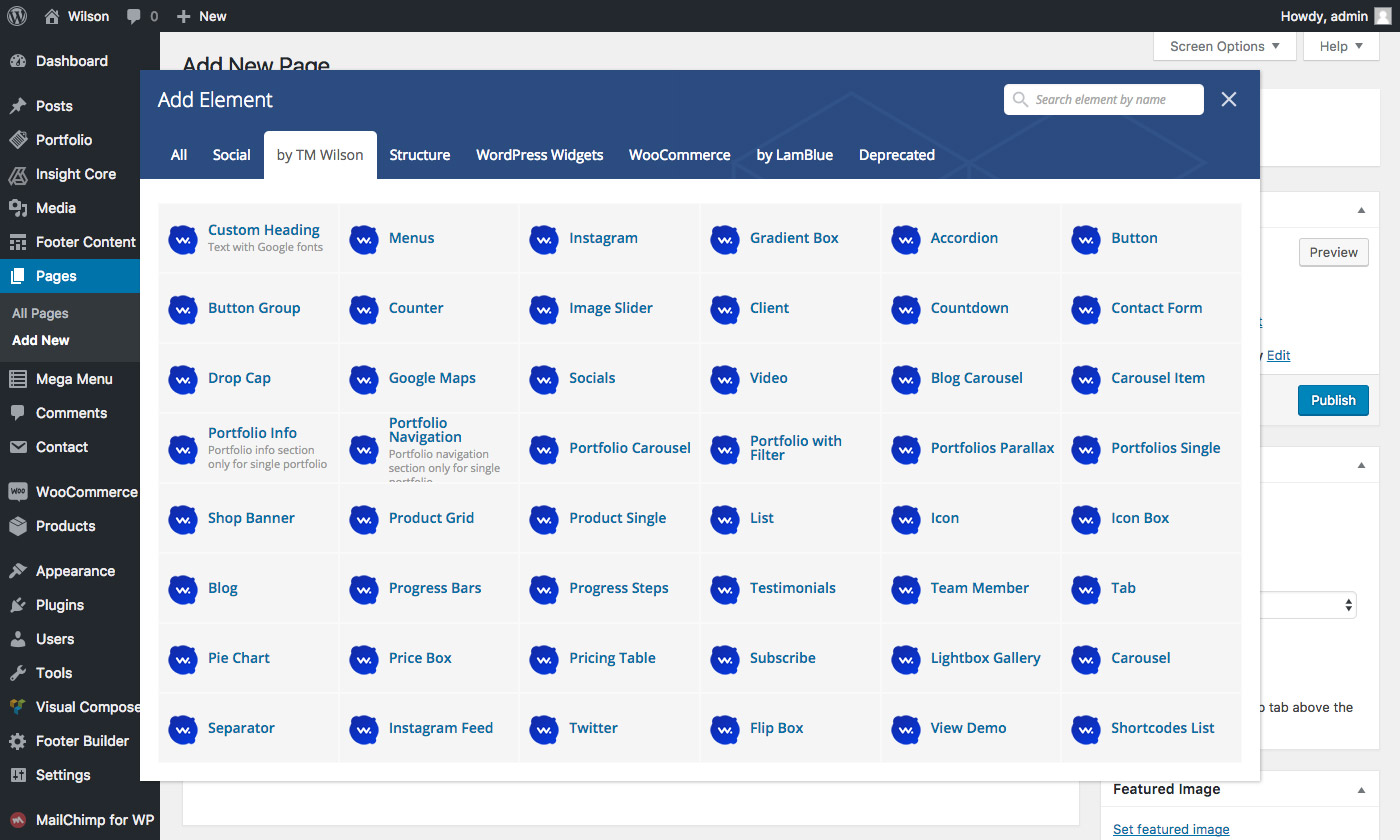
Explore more about Visual Composer here.
How To Change Page Title
Step 1 – Go to Pages > All Pages. Then point at the page you want to
edit. You will see the Quick Edit option.
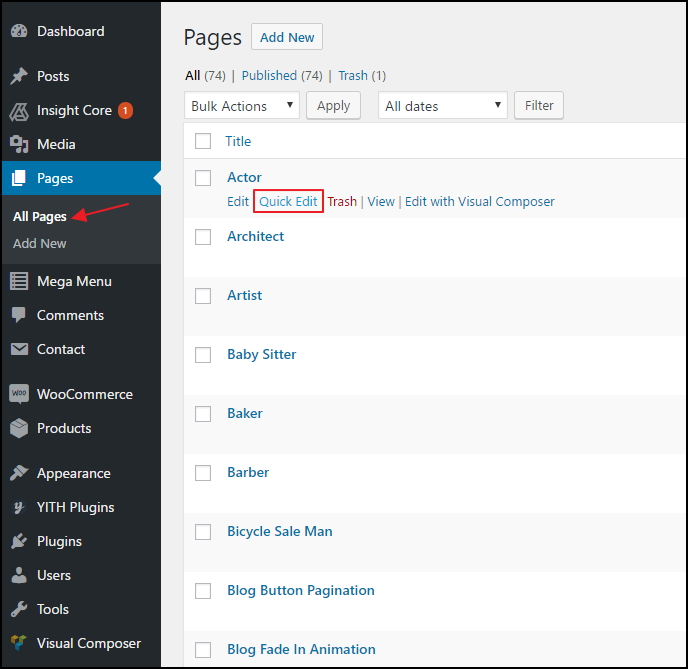
Step 2 – Edit the title as you want. Delete the current slug. Then hit Update.
It will automatically generate new slug for your page.

You can also edit some other options such as parent, template, status... If you want
to edit more options, hit Edit instead of Quick Edit.
Page Templete
Atomlab provides a few Page Templates which support for specific needs of user. For example; you want a page without Header and Footer you can choose Blank Page. What you need to do it select it in Page section of WordPress admin. Page template: Blank Page: This is the Blank page template, when you use this, the header and footer will be removed. Coming Soon 01: Use pre-made coming soon template Coming Soon 02: Use pre-made coming soon template Maintenance: Use pre-made maintenance template One Page Scroll: Create beautiful full screen scrolling page

Select the Page Template and change the sections follow your demand.
Set Up a One-page Site
One-page site is a smart function that let the user show all of your site’s information into one page which split into multiple sections. If you want to know how One page Site works please take a look in Landing product demo Here.

Step 3: Click Edit this Row

You now see a table like this
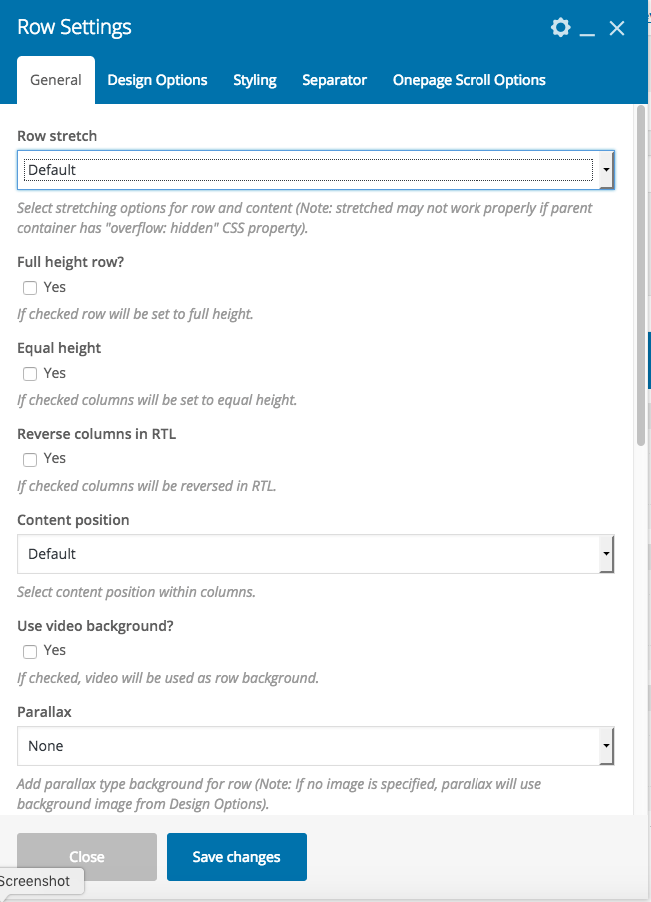
Choose the type of Row Stretch you want and keep rolling down Step 4: Name the Row ID and click Save Change >> Publish or Update

Step 5: Come to Appearance> Menus >> Create a new menu
Step 6: Find Custom Links in the left column
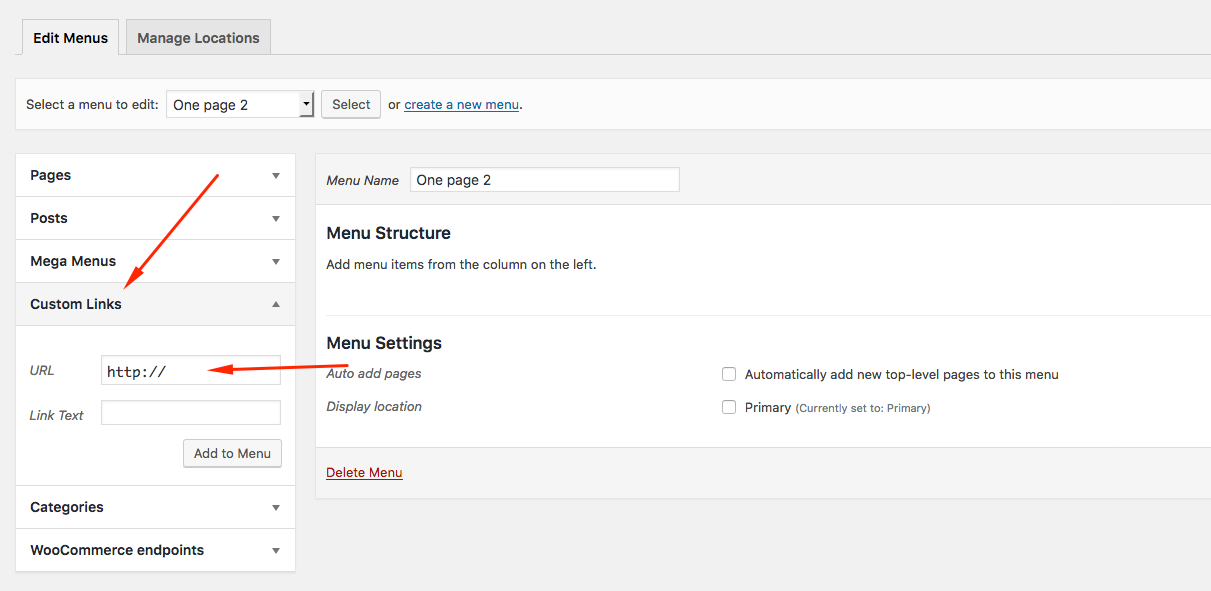
Step 7: Fill URL section by delete http:// and replace by #your row ID in step 4 >> Click Save Menu
Step 8: Back to the page you established and roll down to Page Option >> Header
Step 9: Change Primary Menu to the menu you create in step 5 and Enable One Page Menu

Step 10: Click Update to finish
Header Section
Header
Step 1: Navigate to Appearance from your admin dashboard then click Customize

Step 2: Find Header > General
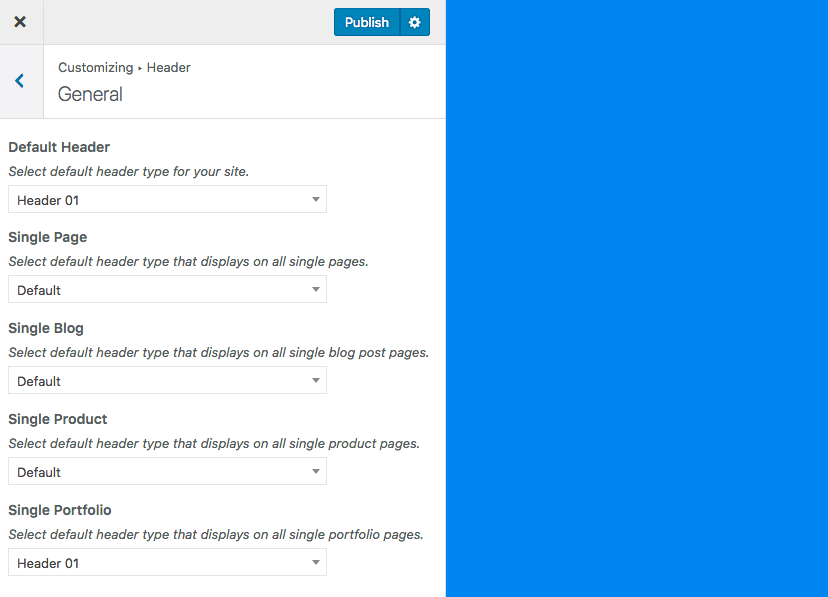
Step 3: Choose the Header style you want in Default Header section. There are 20 different header styles for you to select from.

Now the chosen header style is set to be the default header of all pages. However, you can still a different header style for particular pages, blogs, products or portfolios by setting a style in each section.
Note: If you have imported the demo, the header of the landing page is fixed in page settings (we will discuss this later on in the Page section). Therefore, if you want to try setting up the default header style, you would have to create a new page.
Step 4: Click on Publish button to finish.
Step 1: Navigate to Appearance from your admin dashboard then click Customize. Next, hit Header. You can see a list of available header styles.

Step 2: Double click on the header style you want to customize.
Step 3: Set the configurations listed on the left sidebar.
Note: If you have imported the demo, you will not be able to see the changes you made because the page already had a fixed header style. For your convenience, refer to the following list to find the corresponding header style of each page.
'Header style 01' =>"App Presentation 02"
'Header style 02' =>"Coming Soon 02"
'Header style 03' =>"Coming Soon 01"
'Header style 04' =>"Product"
'Header style 05' =>"Agency"
'Header style 06' =>"Corporate"
'Header style 07' =>"Medical Clinic"
'Header style 08' =>"Shop 01"
'Header style 09' =>"Finance"
'Header style 10' =>"Creative Agency"
'Header style 11' =>"Blog Homepage"
'Header style 12' =>"Conference"
'Header style 13' =>"Support Center"
'Header style 14' =>"Portfolio Homepage"
'Header style 15' => Bonus Header style
'Header style 16' =>"Landing Page"
'Header style 17' =>"Startup 03"
'Header style 18' =>"Creative Studio Video"
'Header style 19' =>"Portfolio 02"
'Header style 20' =>"Blog Magazine"
Step 4: After customizing, do not forget to click Publish button to save your changes.
List of 20 Header styles:




















A sticky header has its position fixed at the top of your webpage even when users scroll down to navigate the page. This allows users to quickly access the menu from any section of the page.
All you need is to hit Header Sticky then Header section.
Now you can enable or disable the Sticky Header.
In addition, you can also customize the height, padding top, padding bottom, color background, etc. of the Sticky Header.
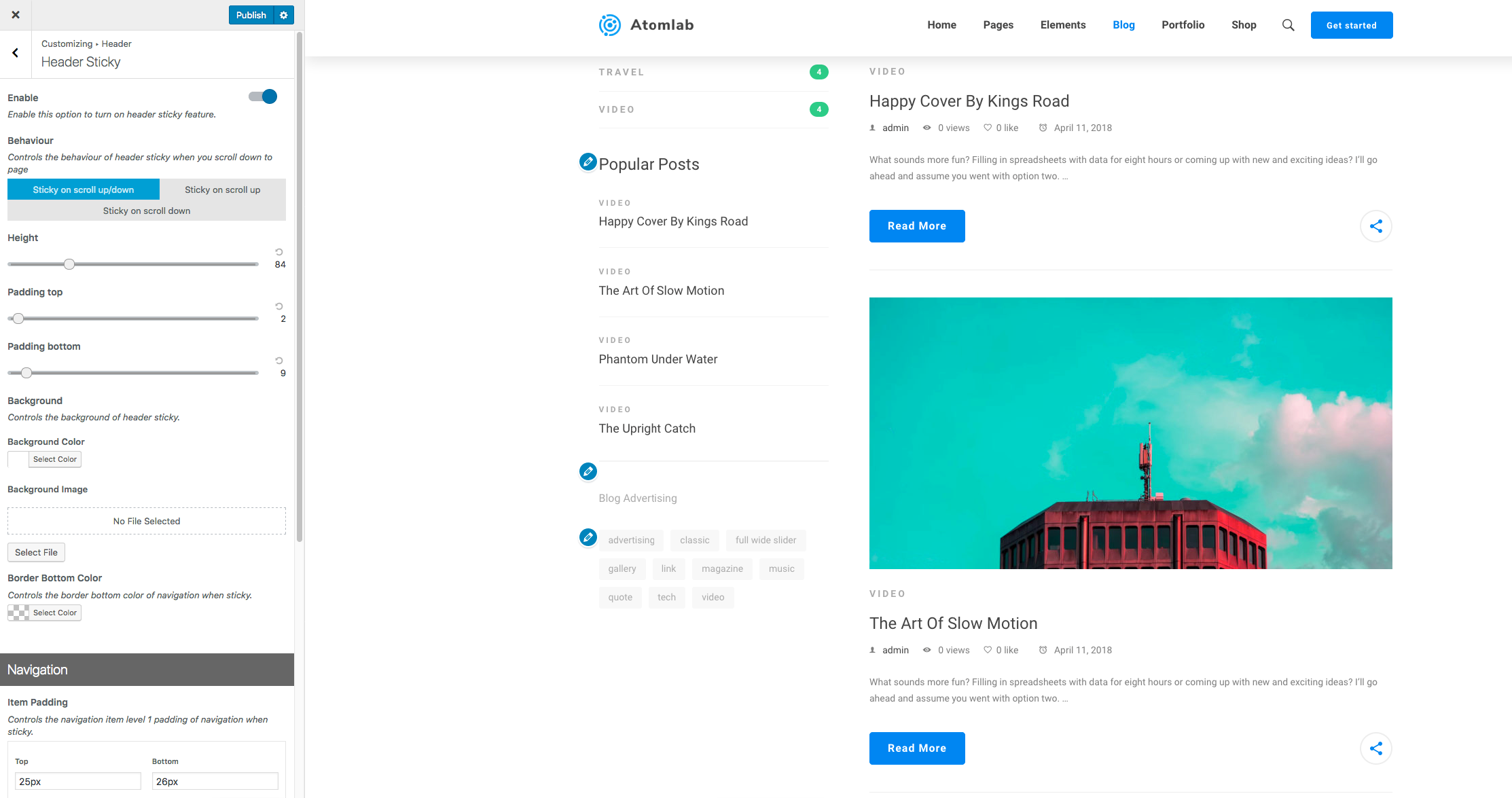
Topbar
Step 1: Similarly, first, you need to go to Appearance from your admin dashboard then click Customize.
Step 2: Then hit Top Bar > General

You can see there are 2 types of Top Bar. You can customize them by clicking on Top Bar 1 button or Top Bar 02.


Step 3: Don’t forget to hit Publish before moving on.
Step 1: Navigate to Appearance >> Customize >> Top Bar
Step 2: Choose the Top Bar style that you want to customize
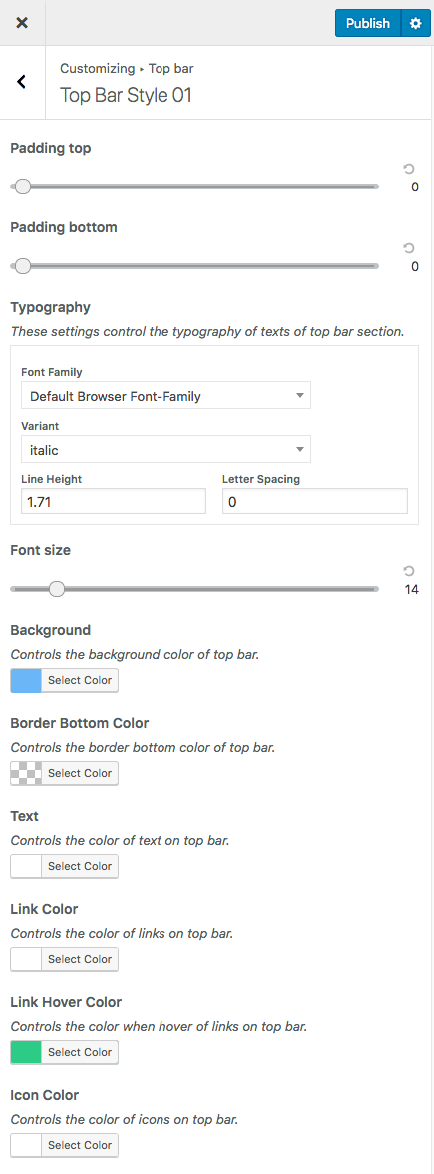
Step 3: Make all the necessary changes then hit Publish button to save your settings.
Page Title Bar
There is only 1 Page Title Bar style, and you have 2 options to show or to hide it.
Step 1: Navigate to Appearance >> Customize >> Page Title Bar
Step 2: Choose General
Now choose to hide or show style 01.
In case you choose style 01, you can customize its title as belows.
For example: Search Heading
This is how the text you enter in this section will display on the search result page.

To hide Page Title Bar:
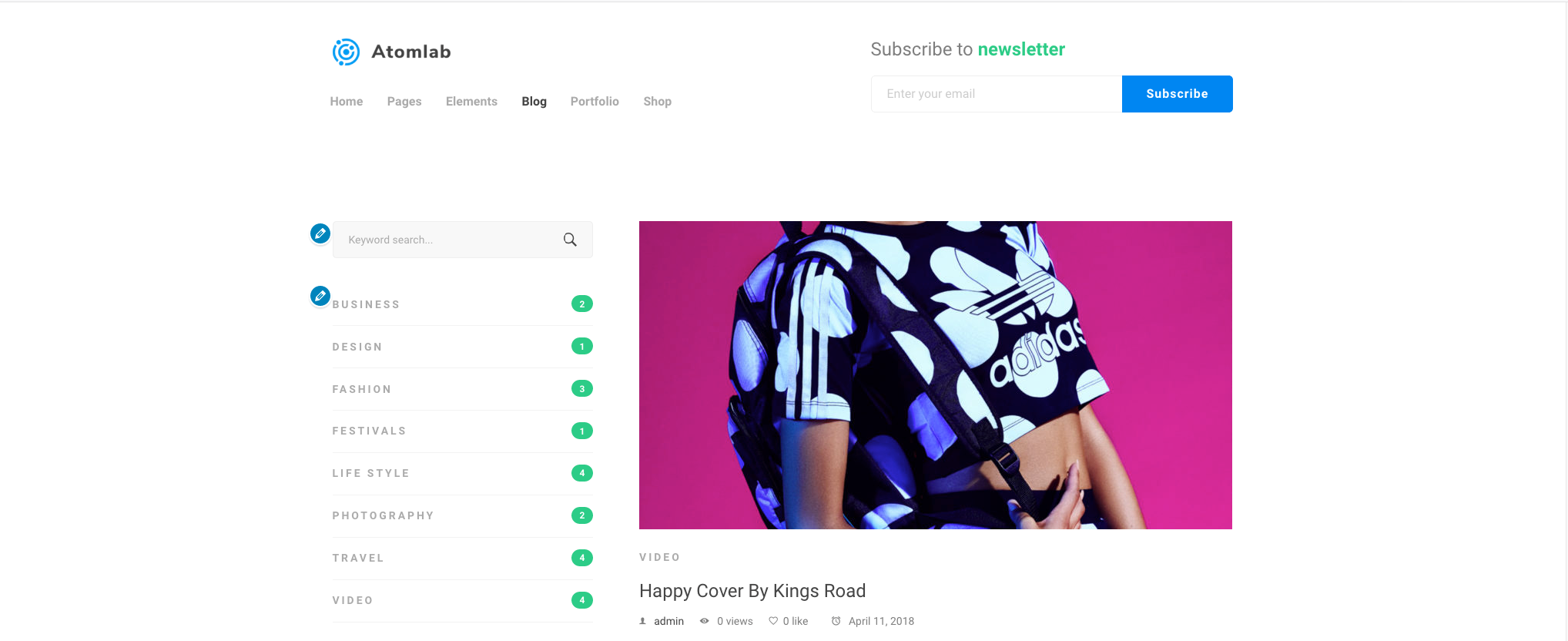
To show Page Title Bar Style 01:

Similarly, you can also choose a different Page Title Bar style for particular pages, blog pages, product pages and portfolio pages.
Note: If you have imported the demo, you won’t be able to customize the Page Title Bar in the landing page. Please create a new page if you would like to try to set a default page tittle bar style.
Step 1: Navigate to Appearance >> Customize >> Page Title Bar
Step 2: Click on the Style 01

Step 3: Customize each section of this style. You can change its color, background, padding, font, etc.
Step 4: Hit Publish button to save the changes.
Menu
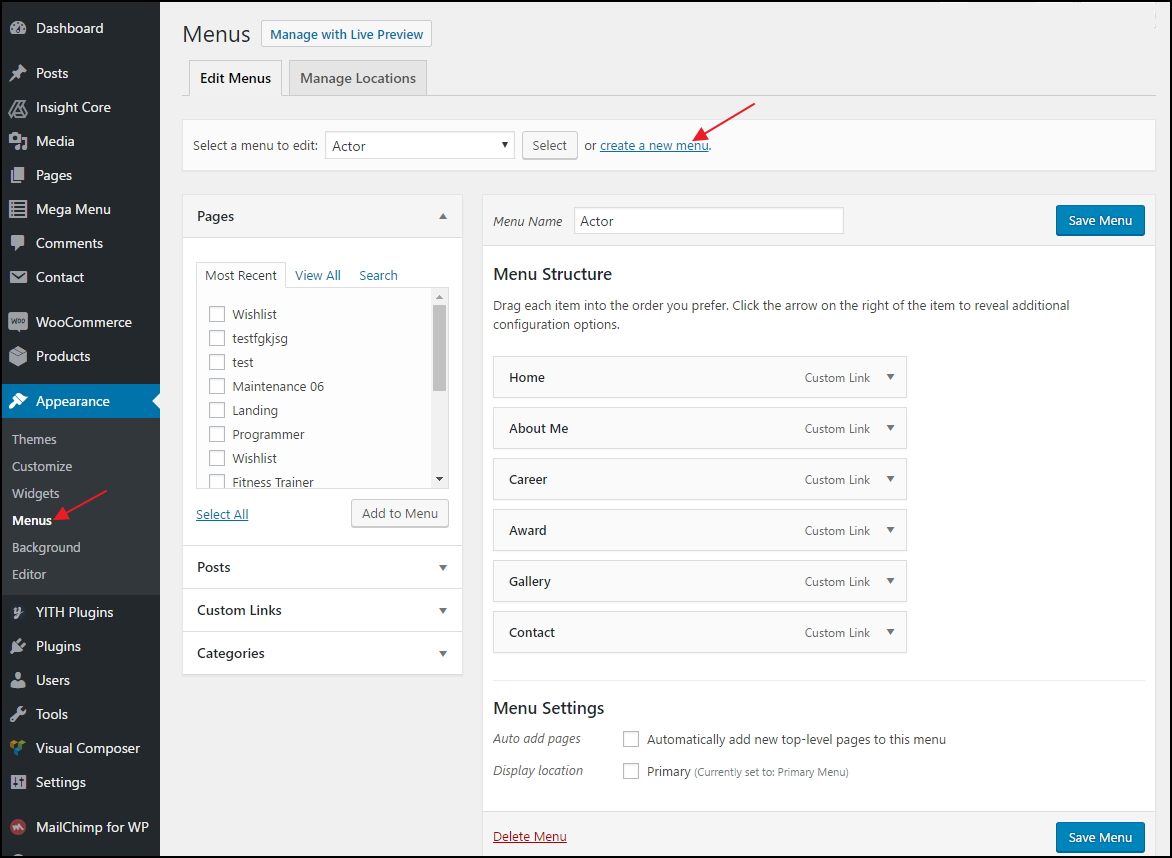
Step 2 – Give your menu a name, then hit Create Menu.
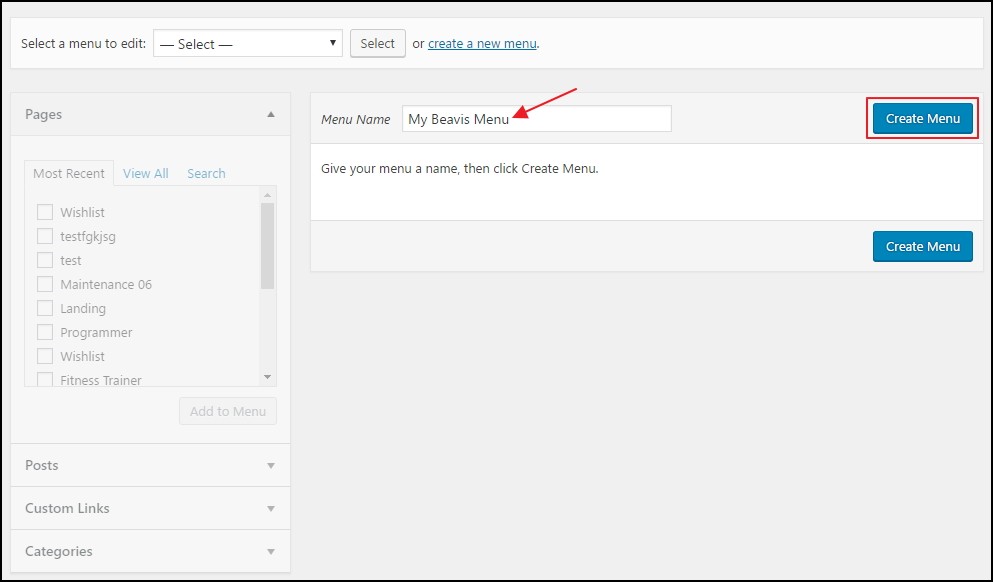
Step 3 – Choose menu items you want to add from the left and hit Add to Menu.
Then hit Save Menu

Your new menu has been created:
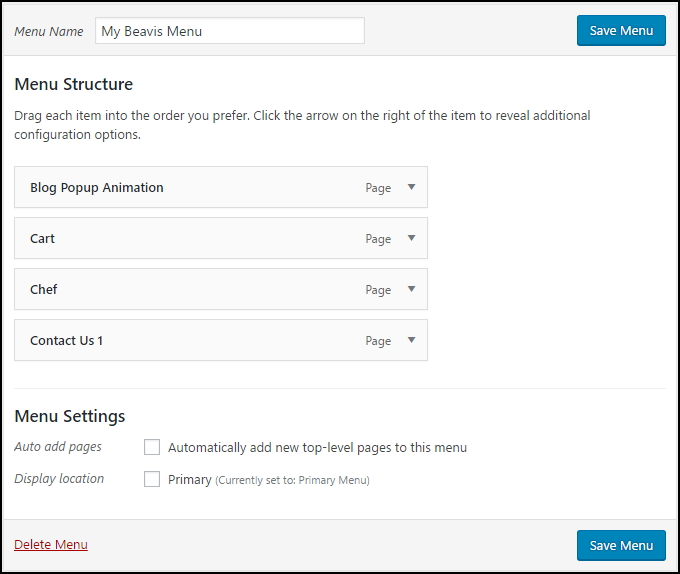
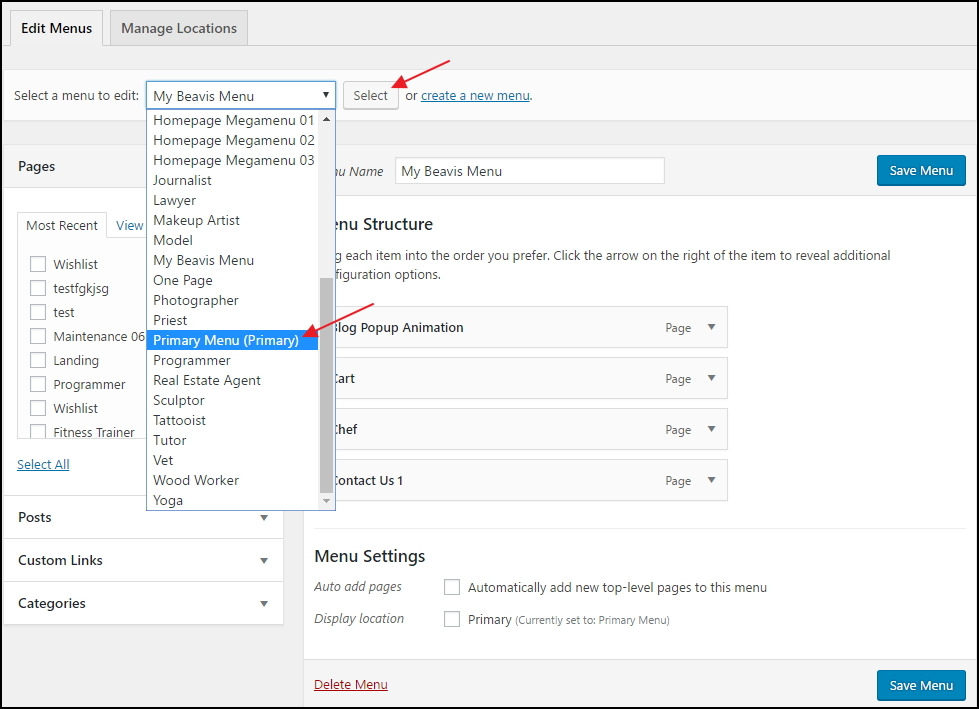
Step 2 – Rename menu name as you wish. If you want to add more menu items, choose them from the left and hit Add to menu.
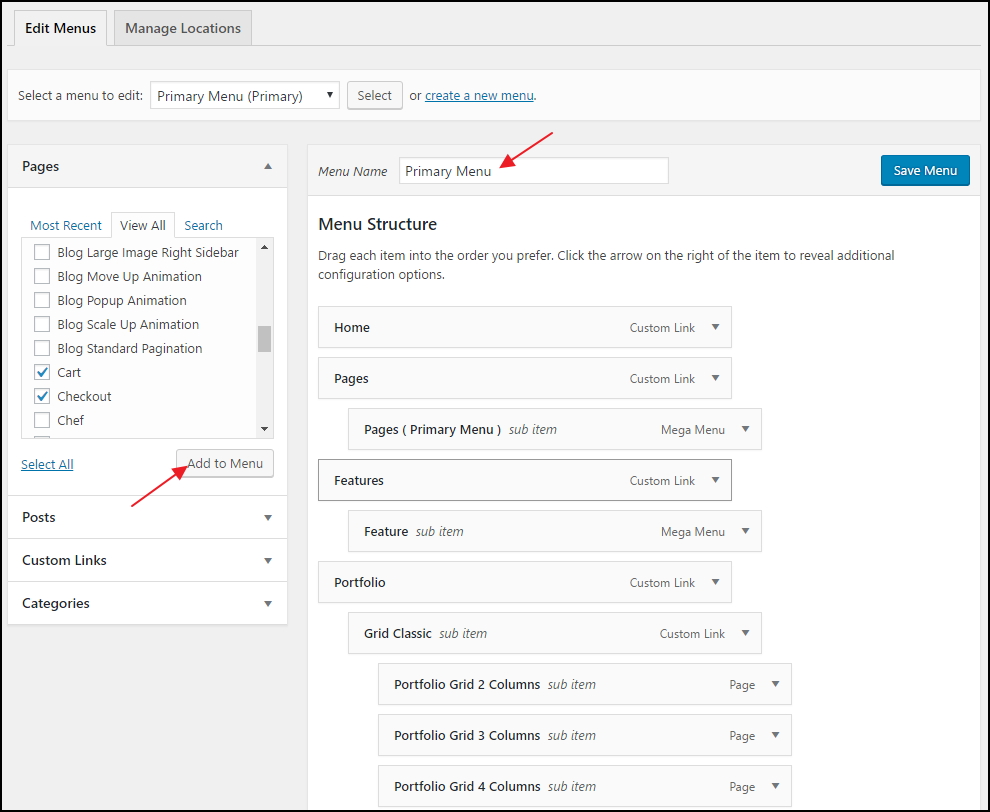
With each menu item, you can rename or drag to make it sub-menu.

Remember to hit Save Menu when you finish editing.

Step 2: Give your menu a name
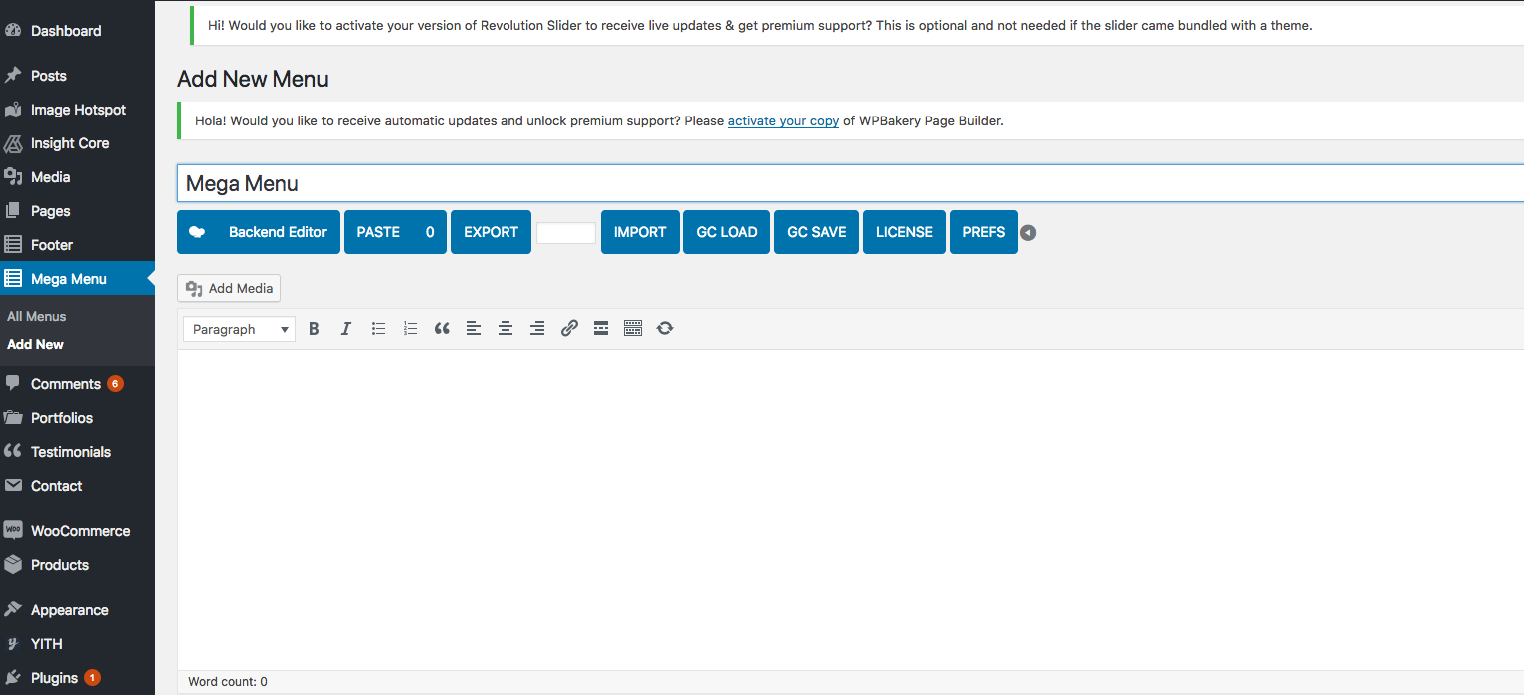
Step 3: Click Backend Editor button.

Step 4: Hit Add Element >> Find Row

Step 5: Choose the type of mega menu to be displayed by clicking on the second option of the top left section.

Step 6: Click “+” button to choose the element you need. Here we have 5 tabs: Content, Structure, By Atomlab, WordPress Widgets, and Deprecated. To create a Mega Menu like shown in the demo, choose By Atomlab >> Widget Better Custom Menu.
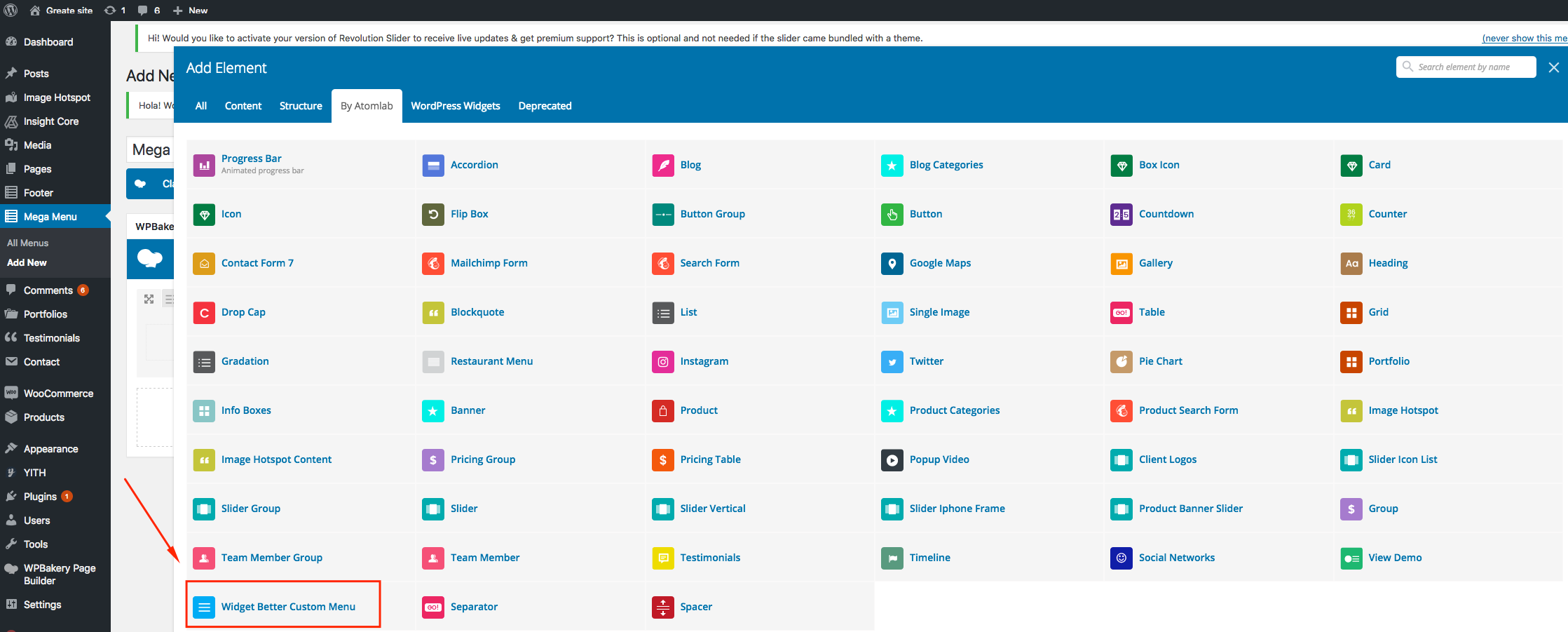
Fill in all fields of the Widget Better Custom Menu settings as belows:

Widget title: Name the title Style: Choose a menu style Style: Choose a menu style Menu: Choose the menu you have created in Menus Extra Class name: (optional) Remember to hit Save Changes. Step 7: Click Publish to apply the settings. To add a new mega menu to your site, navigate to Appearance >> Menus then choose among available menus for a suitable place for your new mega menu:

After successfully creating your mega menu, you’ll need to add it to the Menus. Step 8: Navigate to Appearance >>Menus Step 9: Click on Select a menu to edit then choose the menu you want to add into the mega menu. Step 10: Find the Mega Menus section Step 11:Mark the menu you want to show then hit “Add to Menu”. You can drag then drop them to make them follow your desired order of display. Remember to hit Save Menu to save all of your changes. Note: You cannot add more than 1 mega menu in the parent menu section.
Slider
Create A New Slider
Step 1 – Navigate to Slider Revolution > New Slider.
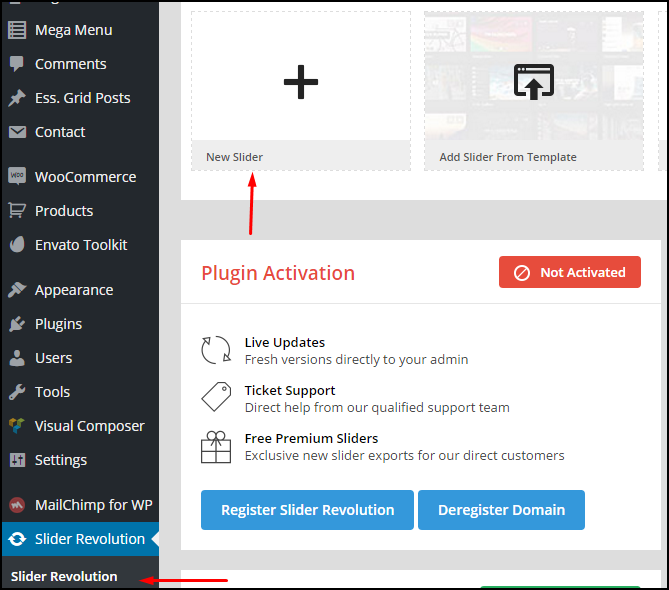
Step 2 – Enter a Slider Name (1) and Slider Alias (2), and click "Save
Settings".


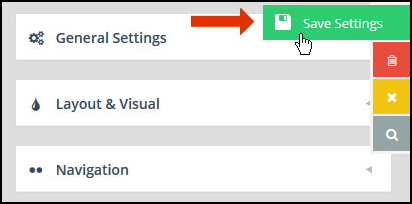
Quick Note:
- Before saving, you can select several of the slider's settings from this page. But choosing these settings are not required to officially create a new slider, as they can be adjusted afterward.
- The slider's "Title" can be anything, but the "Alias" should not have any special characters or spaces (but dashes and underscores are ok).
Step 3 – You'll now be redirected to the plugin's main admin page where you'll
see your new slider listed.
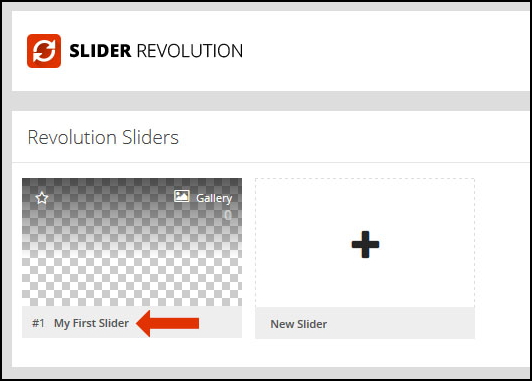
Hover to your new slider, a pen which means "Edit" will appear. Choose that to
start building your slider.
Edit Your Slider
Step 1 – Go to Slider Revolution and hit the slider you want to
edit.
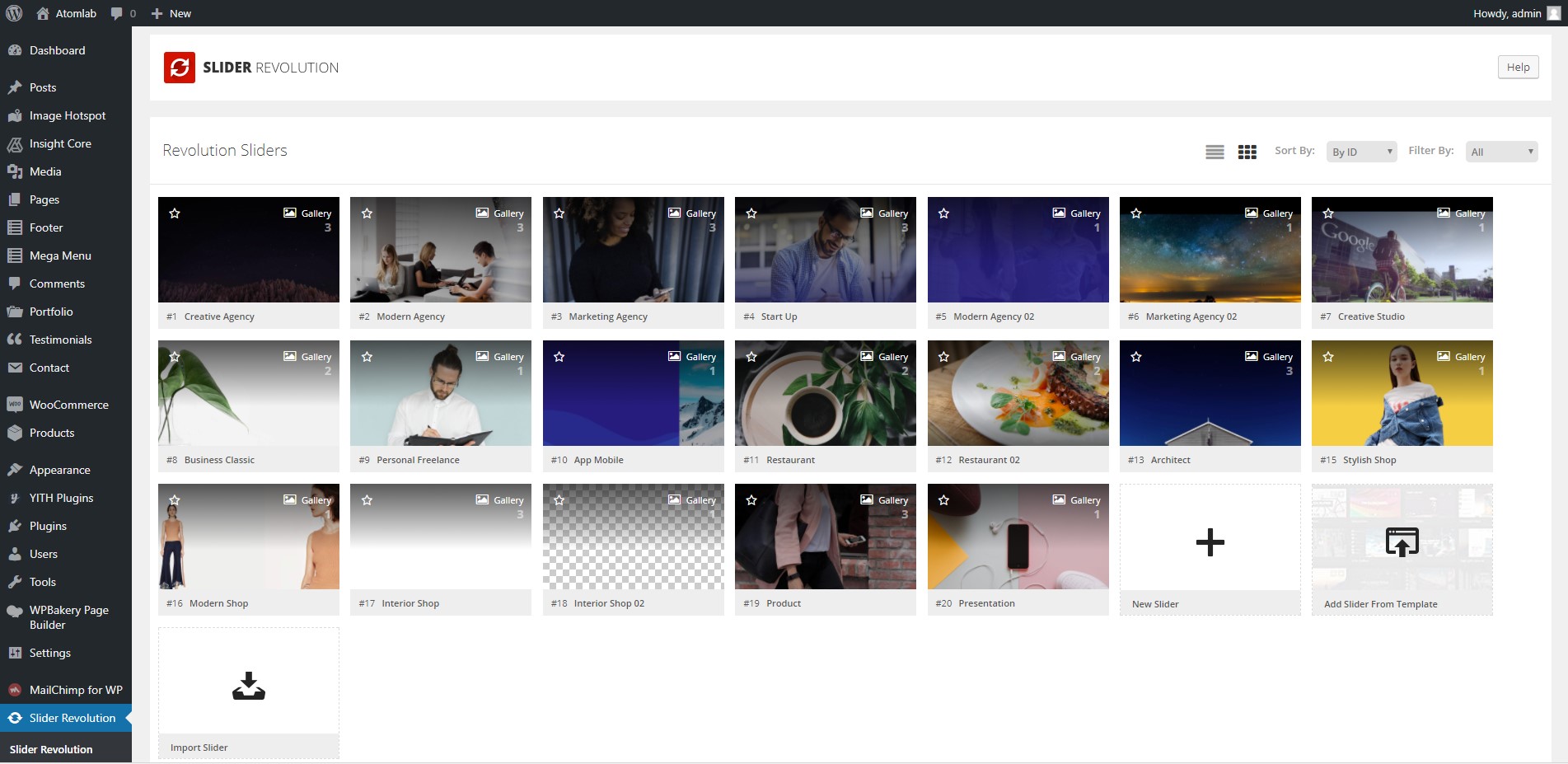
Step 2 – Choose Main/Background Image if you want to change it, then
hit Media Library or Object Library depending on where you want to get
your image.

Navigate to other tabs: General Settings, Thumbnail, Slide Animation, Link & Seo,
Slide Info, Nav. Overwrite to customize. You just have to follow those comprehensive
instructions.
To setting the Slider, please read more in Revolution Documentation.
How to Add Slider in Page
There are 2 ways for you to add Slider in Page
Way 1: Create a new page >> WP Bakery Page Builder >> Plus button >> Choose Revolution Slider 5.
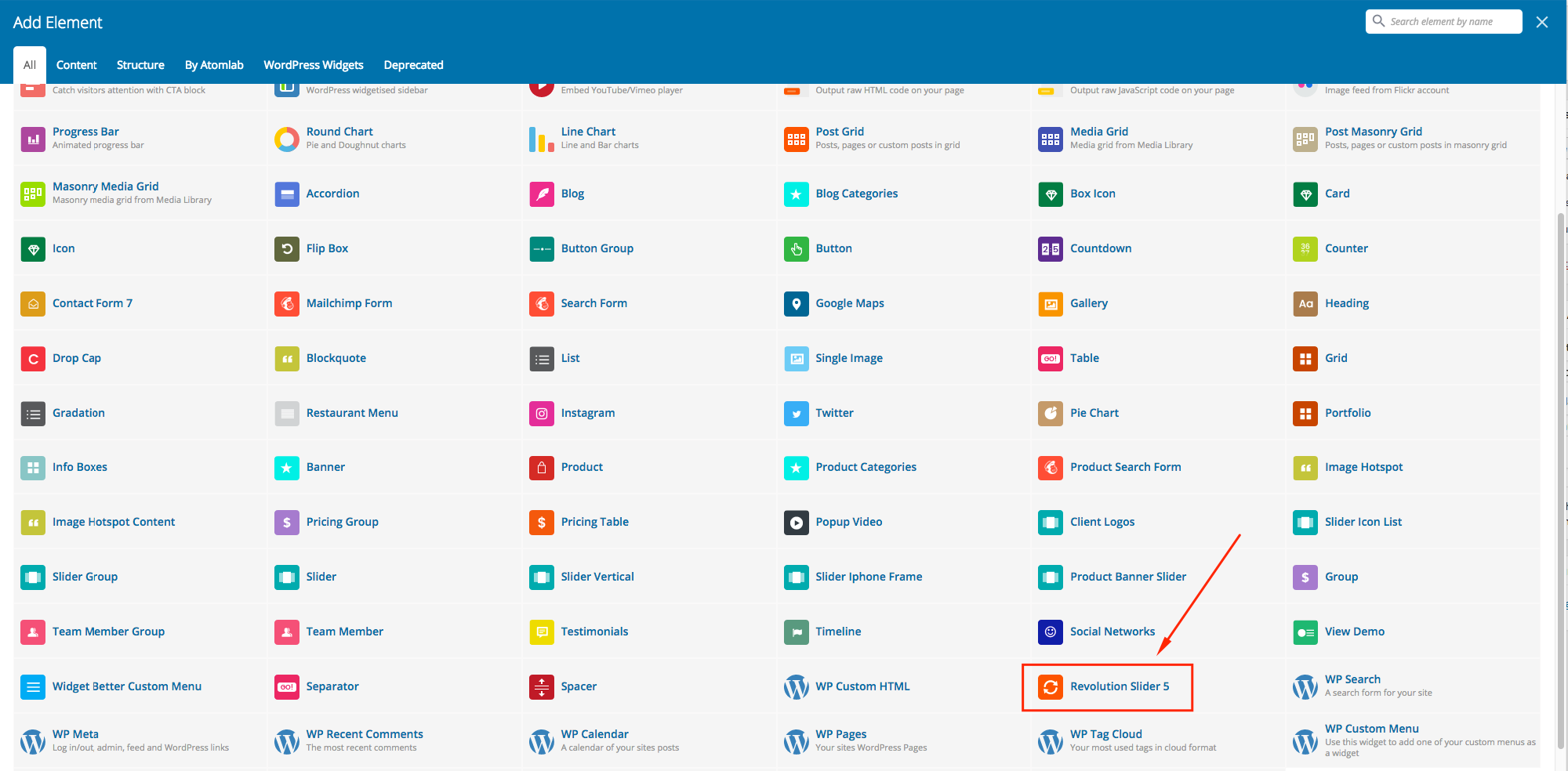
Way 2: Find Sliders section in Page Options box.
Revolution Slider: Choose the available slider you want.
Slider Position: There are 2 positions: Above Header and Below Header.

Portfolio
How to Create Portfolio
Step 1: Navigate to Portfolio >> Add New
Step 2: Name the Porfolio
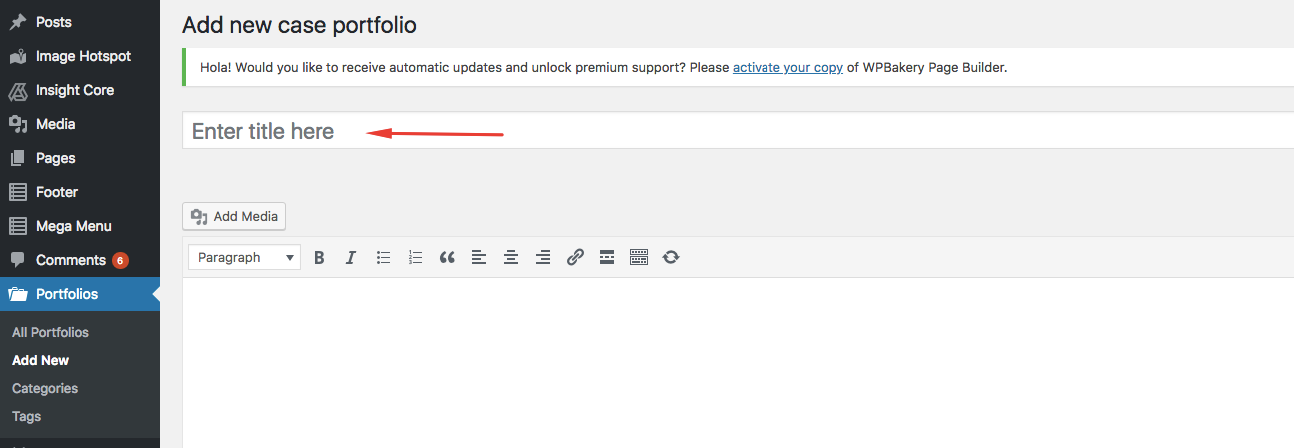
Step 3: Add the content of porfolio you need in the box
Step 4: Roll down to Page Options. You can customize all the sections here.
Single Portfolio style : You can choose the suitable style for your porfolio
Gallery: Add the image you want by clicking to Upload button.
Video Url: in the case you want to add video in thís page, you fill the link of video in this section. (The video from youtube and Vimeo only).
There are other section for example Awards, Team for you to use.
You also can add Feature image by upload image in the right box of the screen.
Step 5: Click Publish to save it.
Widgets
How to Create a Sidebar
Step 1: Navigate to Insight Core>> Sidebars
Step 2: Hit Add New Sidebar button.
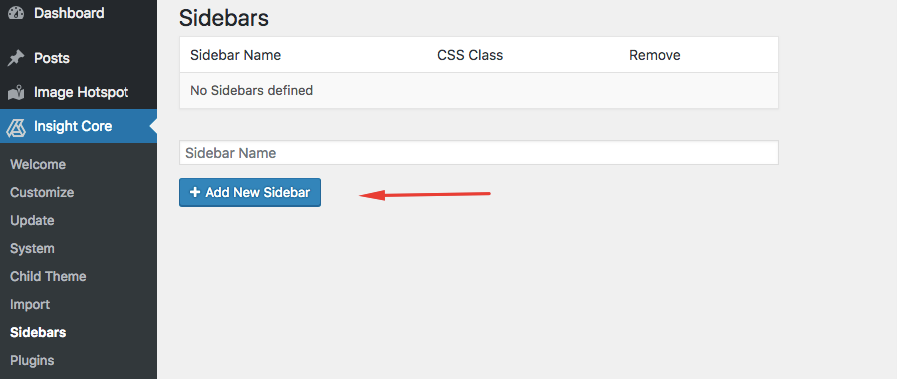
Step 3: Name the Sidebar
Step 4: Hit agin to Add Sidebar
How to Add Widget in Sidebar
Step 1: Appearance >> Widgets. You can see all of the Sidebar here.
Step 2:Choose the Widgets you want and drag it to the Sidebar you want or click on it to choose the Sidebar.
In the case you want to delete its settings, drag it back.

How to choose Sidebar for a group of Page
Step 1: Appearance >> Customize >>Sidebar
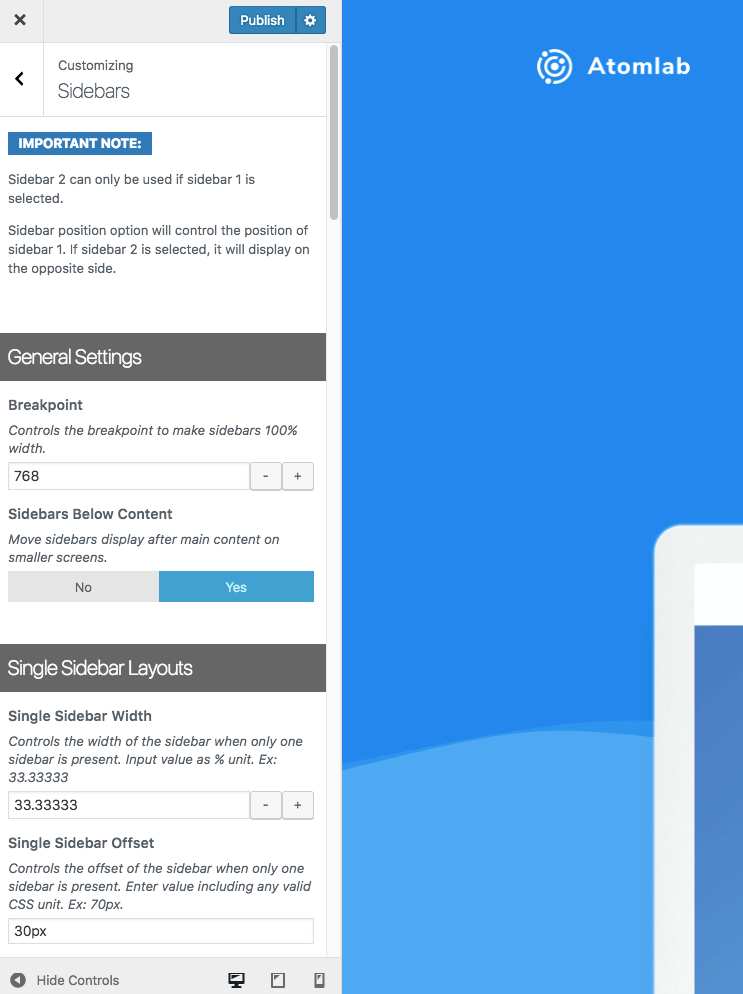
Step 2: Choose the Sidebar you need for each type of page.
Important note:
Sidebar 2 can only be used if sidebar 1 is selected.
Sidebar position option will control the position of Sidebar 1. If Sidebar 2 is selected, it will display on the opposite side.
Step 3: Hit Publish to save the setting.
For individual page, you can choose the Sidebar in Page Option box.
Blog
Create A New Post
Step 1 – Navigate to Posts > Add New in your WordPress admin
sidebar.
Step 2 – Create a title, and insert your post content in the editing
field.
Step 3 – For setting the type of your post, just choose from the
Format field on the right sidebar.
Step 4 – Add Categories from the right side. Categories is meta
information you create for the post. Each category is a meta link that your viewer
can click to view similar type of posts. To assign it to the post, check the box
next to the Category name. You can also access and edit Categories from the Post
sidebar item in your WordPress admin sidebar.
Step 5 – Add Tags from the right side. Tags is meta information you
create for the post. Each tag is a link that your viewer can click to view similar
type of posts. Type the name of the tag in the field, separate multiple tags with
commas. You can also access and edit Tags from the Post sidebar item in your
WordPress admin sidebar.
Step 6 – For a single image, click the first Featured Image Box,
select an image and click the Set Featured Image button.
Step 7 – Once you are finished, click Publish to save the post.
Here is the screenshot that shows the various areas of the blog post page:

Create a Category
Step 1: Post >> Categories
Step 2: Name the category and fill to other section below.
Step 3: Hit Add New Category . Your new Category will aprear in the table of all category immediately.

Similar to Category, you can create a new Tag in the same way.
Create a Blog Archive Page
Step 1: Come to Page >> Add New
Step 2: Name the Page and change from Backend Editor to Classic Mode.
Step 3: Choose Blog element.
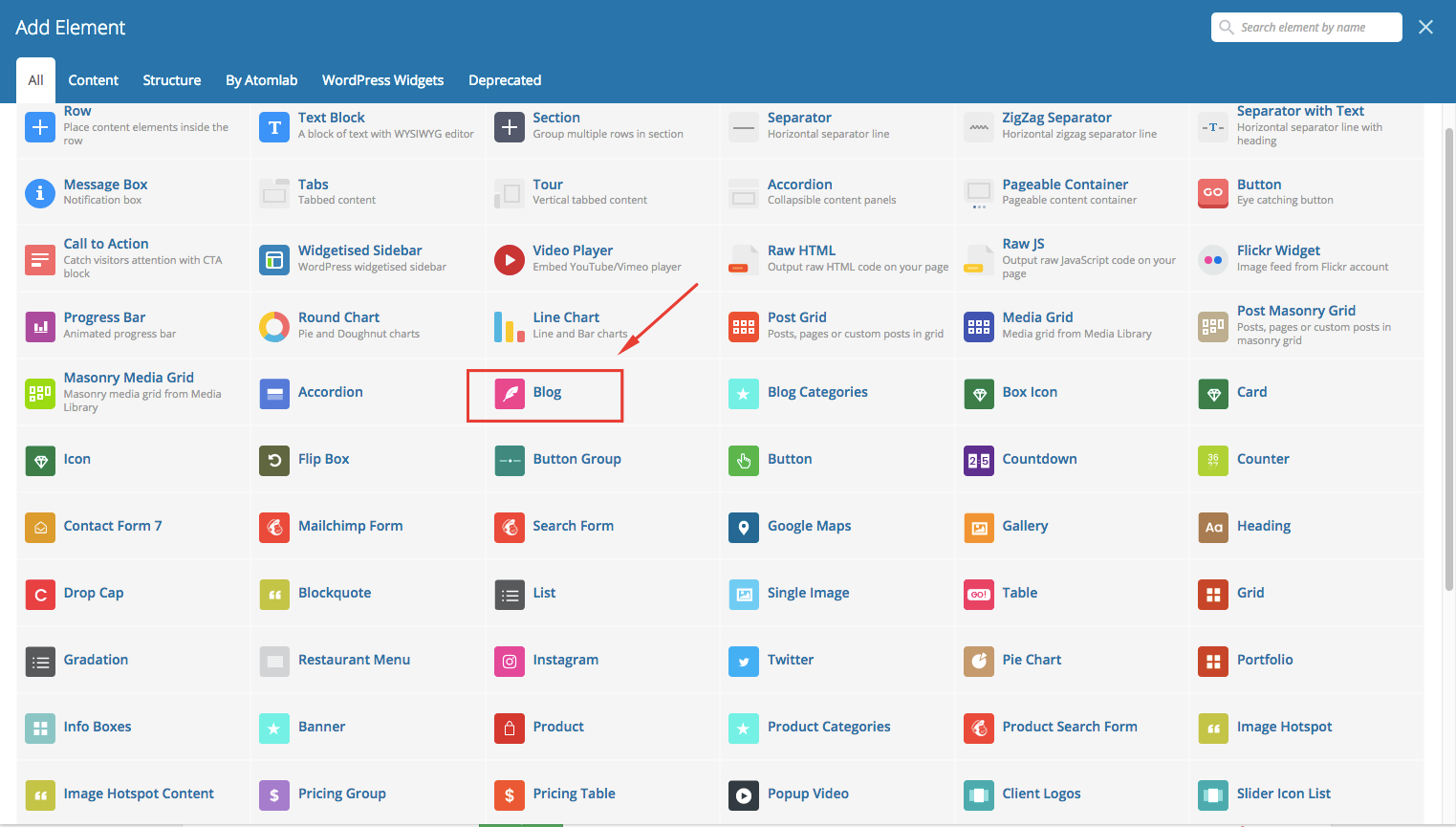
Step 4: Fill all the options in Blog Settings table, especially choose the Blog Style you want.
Step 5: Hit Save Changes to finish.
Step 6: Customize Page Options in WPBakery Page Builder.

Step 7: Hit Publish to save your page.
WooCommerce
Set Up An Online Store
In this section, you’ll learn to set up an online store with WooCommerce
plugin
Step 1 – Be sure that you’ve installed WooCommerce. Check the plugin
section.
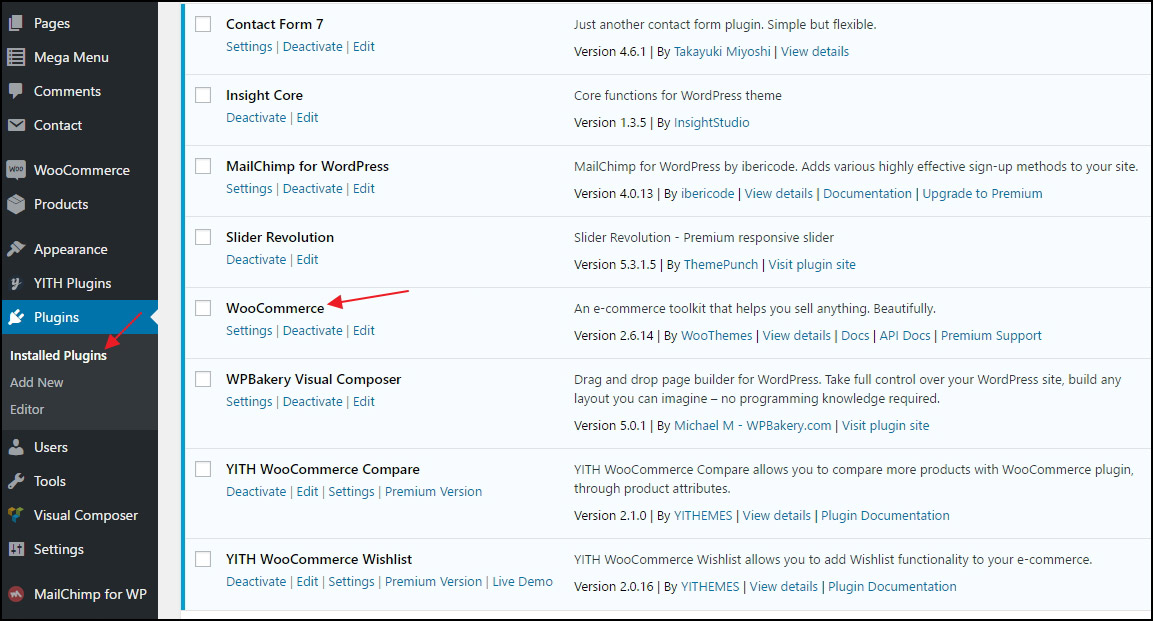
If you haven’t install or activate WooCommerce, get back to Plugin Installation section.
Step 2 – Configure general settings for your WooCommerce store such as
currency, tax, checkout, shipping, etc. by navigating to WooCommerce >
Settings

Step 3 – To create new order: Hit Orders > Add Order.
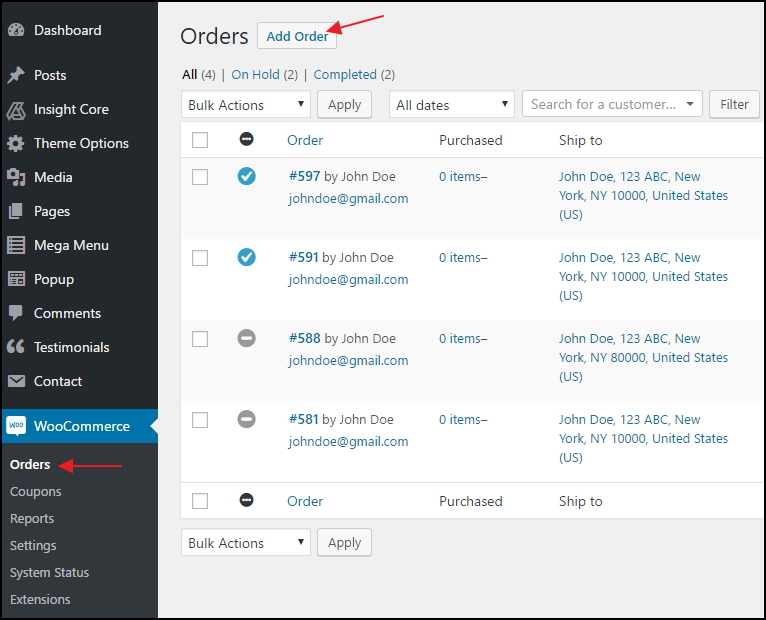
Step 4 – To create new Coupon: Hit Coupons >> Add Coupon.

For more settings of WooCommerce, click here.
FAQs
What Are Common Installation Issues
When you install Atomlab, you may encounter some problems. Check for clarifications
here.
How To Change Color
First, you need to go to Appearance > Customize > Site. These are parts that have color options: Main Color, Link Color...
How To Change Site Indentity
Hit Apperance > Customize > Site Indentity.
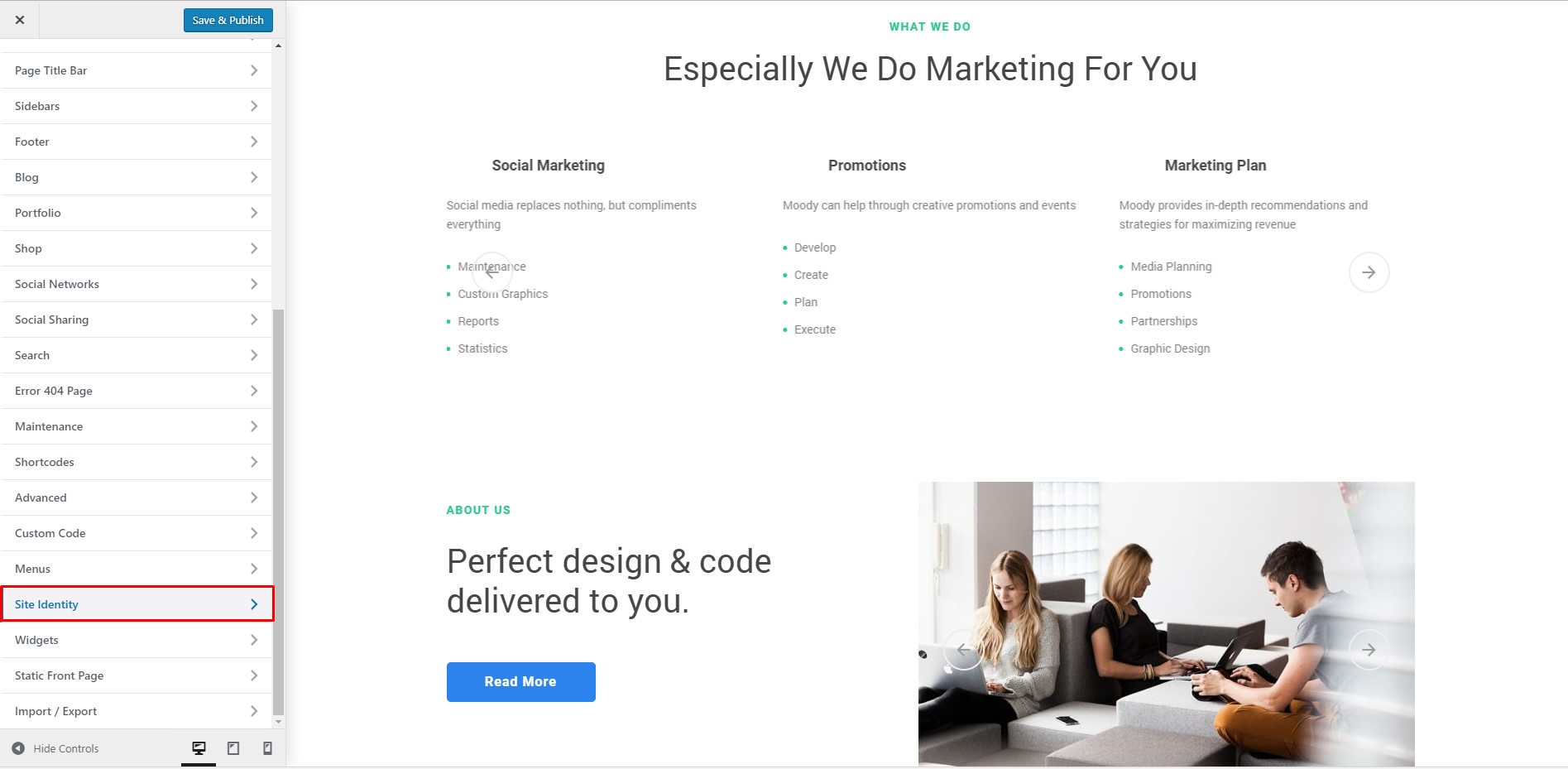
Edit the site title and hit Save & Publish.
